Annotated Bibliography of Financial Planning
VerifiedAdded on 2019/12/28
|19
|7286
|149
Essay
AI Summary
The provided content comprises of several research articles and books related to finance and accounting. The topics covered include M&As in the retail sector, understanding financial statements, corporate finance and investments, bank loan announcements and borrower stock returns, financial ratio analysis of commercial banks, access to finance for innovative SMEs, key performance indicators, and financial planning. These resources provide insights on various aspects of finance such as mergers and acquisitions, financial reporting standards, financial ratios, and investment appraisal. They can be useful for individuals interested in pursuing a career in finance or accounting.
Contribute Materials
Your contribution can guide someone’s learning journey. Share your
documents today.

Managing financial
resource and
decisions
1
resource and
decisions
1
Secure Best Marks with AI Grader
Need help grading? Try our AI Grader for instant feedback on your assignments.
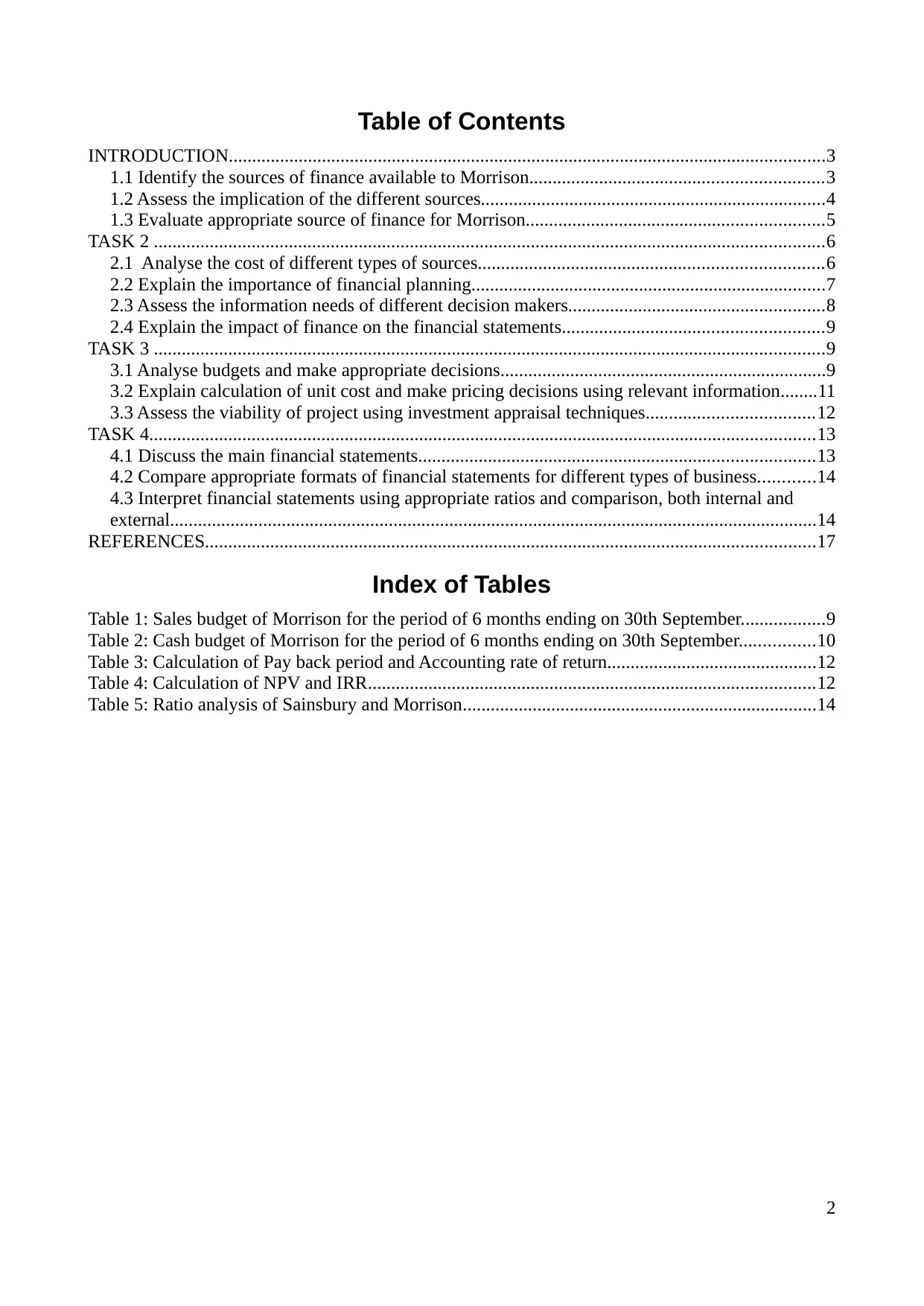
Table of Contents
INTRODUCTION................................................................................................................................3
1.1 Identify the sources of finance available to Morrison...............................................................3
1.2 Assess the implication of the different sources..........................................................................4
1.3 Evaluate appropriate source of finance for Morrison................................................................5
TASK 2 ................................................................................................................................................6
2.1 Analyse the cost of different types of sources..........................................................................6
2.2 Explain the importance of financial planning............................................................................7
2.3 Assess the information needs of different decision makers.......................................................8
2.4 Explain the impact of finance on the financial statements........................................................9
TASK 3 ................................................................................................................................................9
3.1 Analyse budgets and make appropriate decisions......................................................................9
3.2 Explain calculation of unit cost and make pricing decisions using relevant information........11
3.3 Assess the viability of project using investment appraisal techniques....................................12
TASK 4...............................................................................................................................................13
4.1 Discuss the main financial statements.....................................................................................13
4.2 Compare appropriate formats of financial statements for different types of business............14
4.3 Interpret financial statements using appropriate ratios and comparison, both internal and
external...........................................................................................................................................14
REFERENCES...................................................................................................................................17
Index of Tables
Table 1: Sales budget of Morrison for the period of 6 months ending on 30th September..................9
Table 2: Cash budget of Morrison for the period of 6 months ending on 30th September................10
Table 3: Calculation of Pay back period and Accounting rate of return.............................................12
Table 4: Calculation of NPV and IRR................................................................................................12
Table 5: Ratio analysis of Sainsbury and Morrison............................................................................14
2
INTRODUCTION................................................................................................................................3
1.1 Identify the sources of finance available to Morrison...............................................................3
1.2 Assess the implication of the different sources..........................................................................4
1.3 Evaluate appropriate source of finance for Morrison................................................................5
TASK 2 ................................................................................................................................................6
2.1 Analyse the cost of different types of sources..........................................................................6
2.2 Explain the importance of financial planning............................................................................7
2.3 Assess the information needs of different decision makers.......................................................8
2.4 Explain the impact of finance on the financial statements........................................................9
TASK 3 ................................................................................................................................................9
3.1 Analyse budgets and make appropriate decisions......................................................................9
3.2 Explain calculation of unit cost and make pricing decisions using relevant information........11
3.3 Assess the viability of project using investment appraisal techniques....................................12
TASK 4...............................................................................................................................................13
4.1 Discuss the main financial statements.....................................................................................13
4.2 Compare appropriate formats of financial statements for different types of business............14
4.3 Interpret financial statements using appropriate ratios and comparison, both internal and
external...........................................................................................................................................14
REFERENCES...................................................................................................................................17
Index of Tables
Table 1: Sales budget of Morrison for the period of 6 months ending on 30th September..................9
Table 2: Cash budget of Morrison for the period of 6 months ending on 30th September................10
Table 3: Calculation of Pay back period and Accounting rate of return.............................................12
Table 4: Calculation of NPV and IRR................................................................................................12
Table 5: Ratio analysis of Sainsbury and Morrison............................................................................14
2
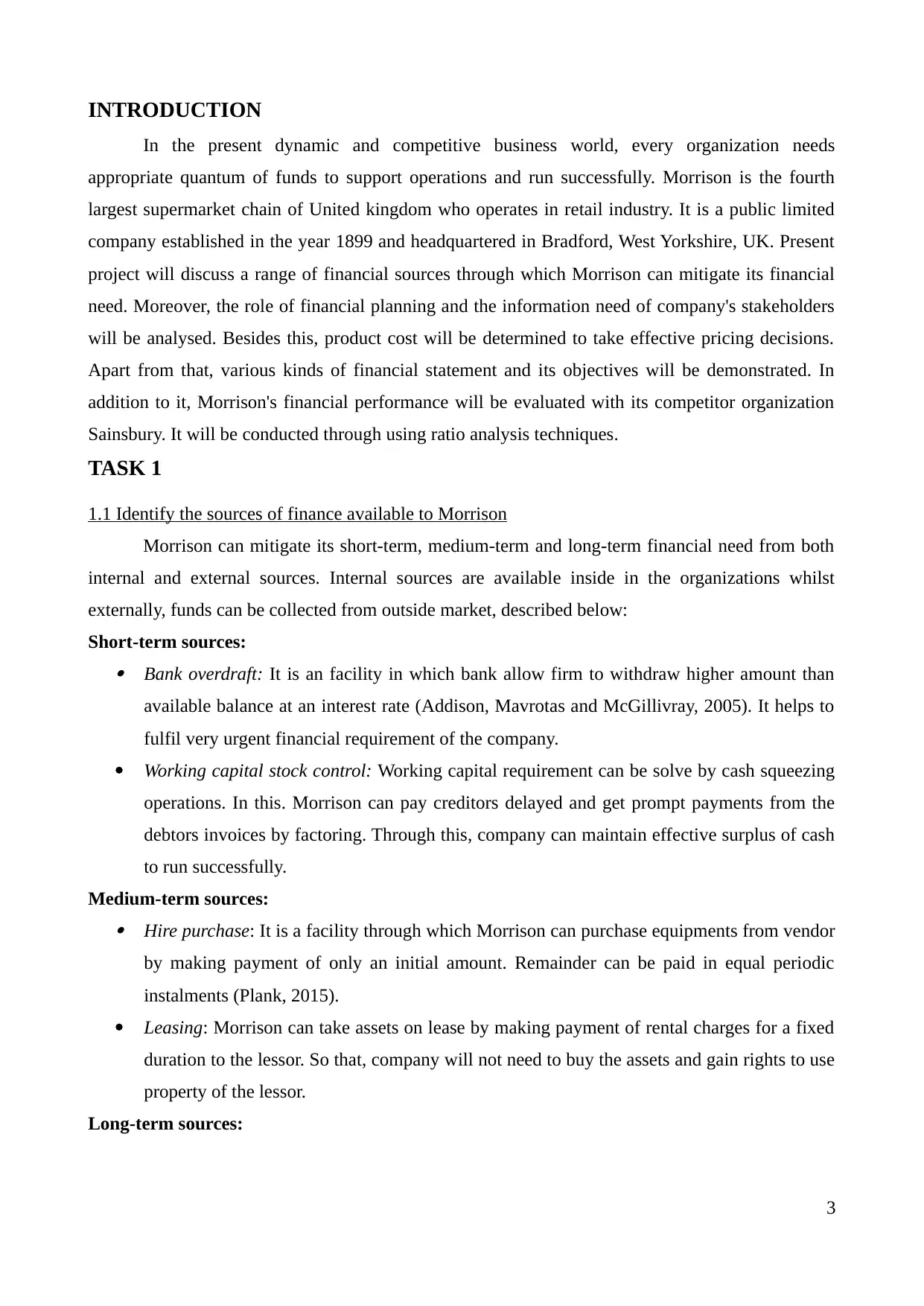
INTRODUCTION
In the present dynamic and competitive business world, every organization needs
appropriate quantum of funds to support operations and run successfully. Morrison is the fourth
largest supermarket chain of United kingdom who operates in retail industry. It is a public limited
company established in the year 1899 and headquartered in Bradford, West Yorkshire, UK. Present
project will discuss a range of financial sources through which Morrison can mitigate its financial
need. Moreover, the role of financial planning and the information need of company's stakeholders
will be analysed. Besides this, product cost will be determined to take effective pricing decisions.
Apart from that, various kinds of financial statement and its objectives will be demonstrated. In
addition to it, Morrison's financial performance will be evaluated with its competitor organization
Sainsbury. It will be conducted through using ratio analysis techniques.
TASK 1
1.1 Identify the sources of finance available to Morrison
Morrison can mitigate its short-term, medium-term and long-term financial need from both
internal and external sources. Internal sources are available inside in the organizations whilst
externally, funds can be collected from outside market, described below:
Short-term sources: Bank overdraft: It is an facility in which bank allow firm to withdraw higher amount than
available balance at an interest rate (Addison, Mavrotas and McGillivray, 2005). It helps to
fulfil very urgent financial requirement of the company.
Working capital stock control: Working capital requirement can be solve by cash squeezing
operations. In this. Morrison can pay creditors delayed and get prompt payments from the
debtors invoices by factoring. Through this, company can maintain effective surplus of cash
to run successfully.
Medium-term sources: Hire purchase: It is a facility through which Morrison can purchase equipments from vendor
by making payment of only an initial amount. Remainder can be paid in equal periodic
instalments (Plank, 2015).
Leasing: Morrison can take assets on lease by making payment of rental charges for a fixed
duration to the lessor. So that, company will not need to buy the assets and gain rights to use
property of the lessor.
Long-term sources:
3
In the present dynamic and competitive business world, every organization needs
appropriate quantum of funds to support operations and run successfully. Morrison is the fourth
largest supermarket chain of United kingdom who operates in retail industry. It is a public limited
company established in the year 1899 and headquartered in Bradford, West Yorkshire, UK. Present
project will discuss a range of financial sources through which Morrison can mitigate its financial
need. Moreover, the role of financial planning and the information need of company's stakeholders
will be analysed. Besides this, product cost will be determined to take effective pricing decisions.
Apart from that, various kinds of financial statement and its objectives will be demonstrated. In
addition to it, Morrison's financial performance will be evaluated with its competitor organization
Sainsbury. It will be conducted through using ratio analysis techniques.
TASK 1
1.1 Identify the sources of finance available to Morrison
Morrison can mitigate its short-term, medium-term and long-term financial need from both
internal and external sources. Internal sources are available inside in the organizations whilst
externally, funds can be collected from outside market, described below:
Short-term sources: Bank overdraft: It is an facility in which bank allow firm to withdraw higher amount than
available balance at an interest rate (Addison, Mavrotas and McGillivray, 2005). It helps to
fulfil very urgent financial requirement of the company.
Working capital stock control: Working capital requirement can be solve by cash squeezing
operations. In this. Morrison can pay creditors delayed and get prompt payments from the
debtors invoices by factoring. Through this, company can maintain effective surplus of cash
to run successfully.
Medium-term sources: Hire purchase: It is a facility through which Morrison can purchase equipments from vendor
by making payment of only an initial amount. Remainder can be paid in equal periodic
instalments (Plank, 2015).
Leasing: Morrison can take assets on lease by making payment of rental charges for a fixed
duration to the lessor. So that, company will not need to buy the assets and gain rights to use
property of the lessor.
Long-term sources:
3
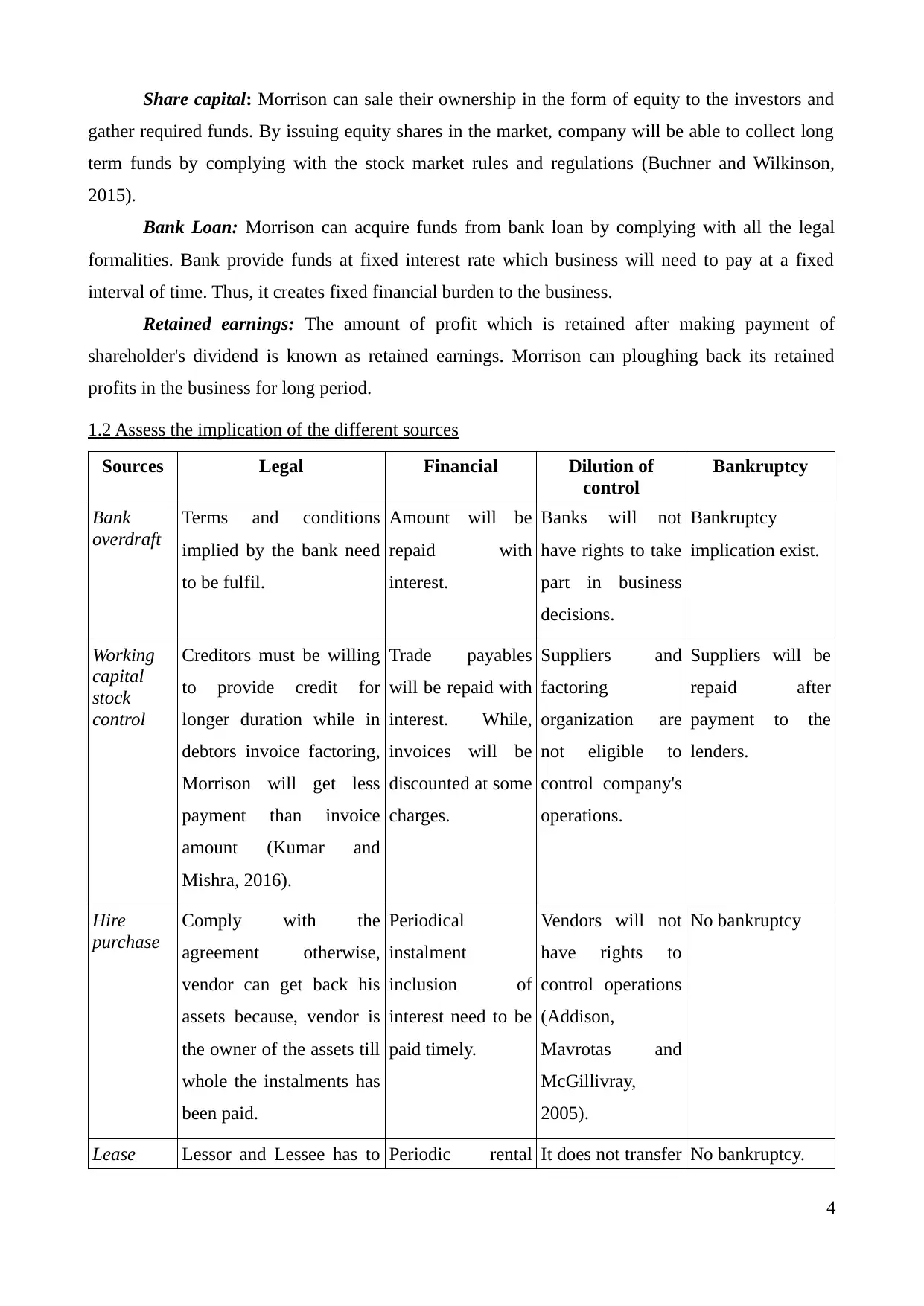
Share capital: Morrison can sale their ownership in the form of equity to the investors and
gather required funds. By issuing equity shares in the market, company will be able to collect long
term funds by complying with the stock market rules and regulations (Buchner and Wilkinson,
2015).
Bank Loan: Morrison can acquire funds from bank loan by complying with all the legal
formalities. Bank provide funds at fixed interest rate which business will need to pay at a fixed
interval of time. Thus, it creates fixed financial burden to the business.
Retained earnings: The amount of profit which is retained after making payment of
shareholder's dividend is known as retained earnings. Morrison can ploughing back its retained
profits in the business for long period.
1.2 Assess the implication of the different sources
Sources Legal Financial Dilution of
control
Bankruptcy
Bank
overdraft
Terms and conditions
implied by the bank need
to be fulfil.
Amount will be
repaid with
interest.
Banks will not
have rights to take
part in business
decisions.
Bankruptcy
implication exist.
Working
capital
stock
control
Creditors must be willing
to provide credit for
longer duration while in
debtors invoice factoring,
Morrison will get less
payment than invoice
amount (Kumar and
Mishra, 2016).
Trade payables
will be repaid with
interest. While,
invoices will be
discounted at some
charges.
Suppliers and
factoring
organization are
not eligible to
control company's
operations.
Suppliers will be
repaid after
payment to the
lenders.
Hire
purchase
Comply with the
agreement otherwise,
vendor can get back his
assets because, vendor is
the owner of the assets till
whole the instalments has
been paid.
Periodical
instalment
inclusion of
interest need to be
paid timely.
Vendors will not
have rights to
control operations
(Addison,
Mavrotas and
McGillivray,
2005).
No bankruptcy
Lease Lessor and Lessee has to Periodic rental It does not transfer No bankruptcy.
4
gather required funds. By issuing equity shares in the market, company will be able to collect long
term funds by complying with the stock market rules and regulations (Buchner and Wilkinson,
2015).
Bank Loan: Morrison can acquire funds from bank loan by complying with all the legal
formalities. Bank provide funds at fixed interest rate which business will need to pay at a fixed
interval of time. Thus, it creates fixed financial burden to the business.
Retained earnings: The amount of profit which is retained after making payment of
shareholder's dividend is known as retained earnings. Morrison can ploughing back its retained
profits in the business for long period.
1.2 Assess the implication of the different sources
Sources Legal Financial Dilution of
control
Bankruptcy
Bank
overdraft
Terms and conditions
implied by the bank need
to be fulfil.
Amount will be
repaid with
interest.
Banks will not
have rights to take
part in business
decisions.
Bankruptcy
implication exist.
Working
capital
stock
control
Creditors must be willing
to provide credit for
longer duration while in
debtors invoice factoring,
Morrison will get less
payment than invoice
amount (Kumar and
Mishra, 2016).
Trade payables
will be repaid with
interest. While,
invoices will be
discounted at some
charges.
Suppliers and
factoring
organization are
not eligible to
control company's
operations.
Suppliers will be
repaid after
payment to the
lenders.
Hire
purchase
Comply with the
agreement otherwise,
vendor can get back his
assets because, vendor is
the owner of the assets till
whole the instalments has
been paid.
Periodical
instalment
inclusion of
interest need to be
paid timely.
Vendors will not
have rights to
control operations
(Addison,
Mavrotas and
McGillivray,
2005).
No bankruptcy
Lease Lessor and Lessee has to Periodic rental It does not transfer No bankruptcy.
4
Secure Best Marks with AI Grader
Need help grading? Try our AI Grader for instant feedback on your assignments.
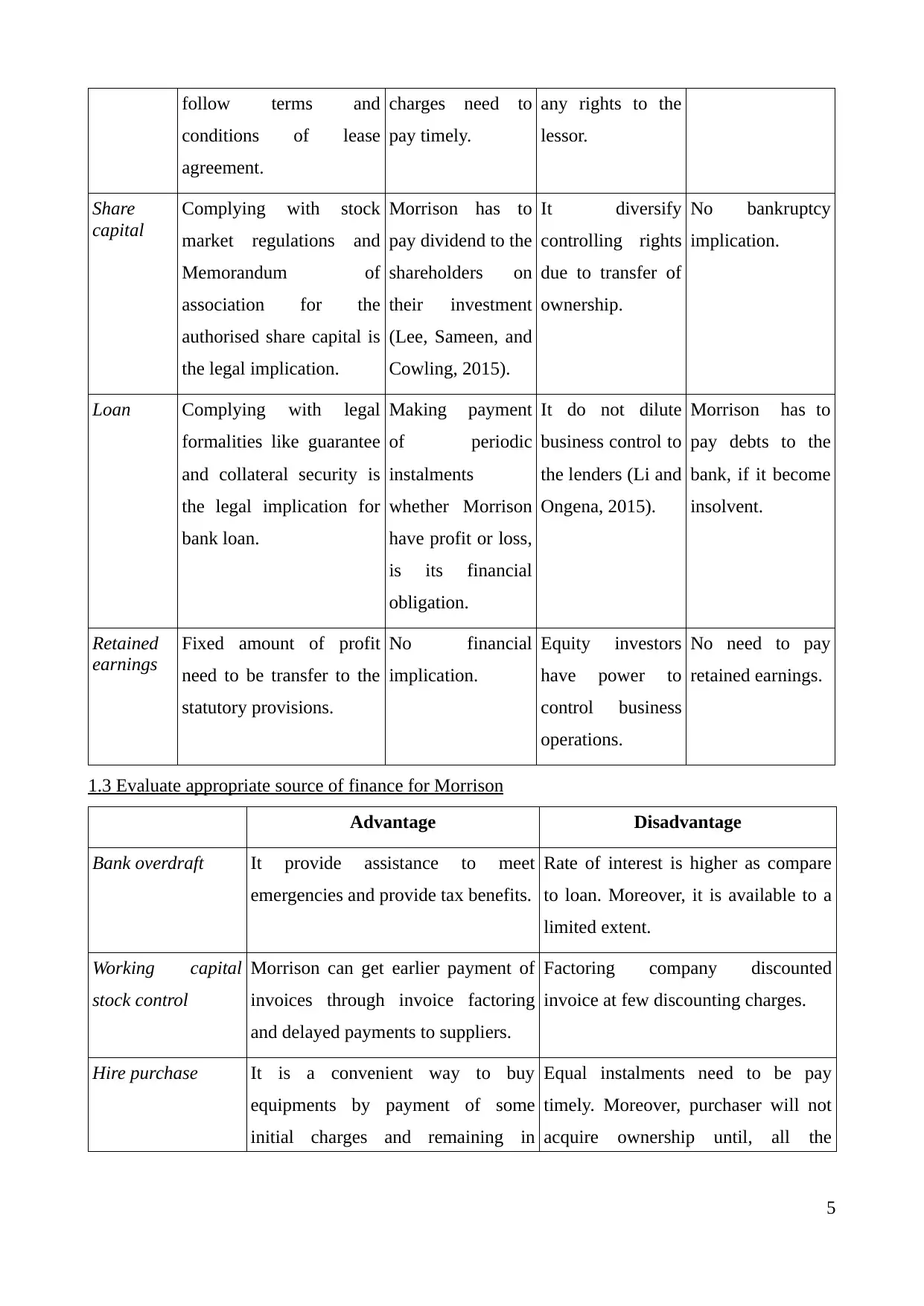
follow terms and
conditions of lease
agreement.
charges need to
pay timely.
any rights to the
lessor.
Share
capital
Complying with stock
market regulations and
Memorandum of
association for the
authorised share capital is
the legal implication.
Morrison has to
pay dividend to the
shareholders on
their investment
(Lee, Sameen, and
Cowling, 2015).
It diversify
controlling rights
due to transfer of
ownership.
No bankruptcy
implication.
Loan Complying with legal
formalities like guarantee
and collateral security is
the legal implication for
bank loan.
Making payment
of periodic
instalments
whether Morrison
have profit or loss,
is its financial
obligation.
It do not dilute
business control to
the lenders (Li and
Ongena, 2015).
Morrison has to
pay debts to the
bank, if it become
insolvent.
Retained
earnings
Fixed amount of profit
need to be transfer to the
statutory provisions.
No financial
implication.
Equity investors
have power to
control business
operations.
No need to pay
retained earnings.
1.3 Evaluate appropriate source of finance for Morrison
Advantage Disadvantage
Bank overdraft It provide assistance to meet
emergencies and provide tax benefits.
Rate of interest is higher as compare
to loan. Moreover, it is available to a
limited extent.
Working capital
stock control
Morrison can get earlier payment of
invoices through invoice factoring
and delayed payments to suppliers.
Factoring company discounted
invoice at few discounting charges.
Hire purchase It is a convenient way to buy
equipments by payment of some
initial charges and remaining in
Equal instalments need to be pay
timely. Moreover, purchaser will not
acquire ownership until, all the
5
conditions of lease
agreement.
charges need to
pay timely.
any rights to the
lessor.
Share
capital
Complying with stock
market regulations and
Memorandum of
association for the
authorised share capital is
the legal implication.
Morrison has to
pay dividend to the
shareholders on
their investment
(Lee, Sameen, and
Cowling, 2015).
It diversify
controlling rights
due to transfer of
ownership.
No bankruptcy
implication.
Loan Complying with legal
formalities like guarantee
and collateral security is
the legal implication for
bank loan.
Making payment
of periodic
instalments
whether Morrison
have profit or loss,
is its financial
obligation.
It do not dilute
business control to
the lenders (Li and
Ongena, 2015).
Morrison has to
pay debts to the
bank, if it become
insolvent.
Retained
earnings
Fixed amount of profit
need to be transfer to the
statutory provisions.
No financial
implication.
Equity investors
have power to
control business
operations.
No need to pay
retained earnings.
1.3 Evaluate appropriate source of finance for Morrison
Advantage Disadvantage
Bank overdraft It provide assistance to meet
emergencies and provide tax benefits.
Rate of interest is higher as compare
to loan. Moreover, it is available to a
limited extent.
Working capital
stock control
Morrison can get earlier payment of
invoices through invoice factoring
and delayed payments to suppliers.
Factoring company discounted
invoice at few discounting charges.
Hire purchase It is a convenient way to buy
equipments by payment of some
initial charges and remaining in
Equal instalments need to be pay
timely. Moreover, purchaser will not
acquire ownership until, all the
5
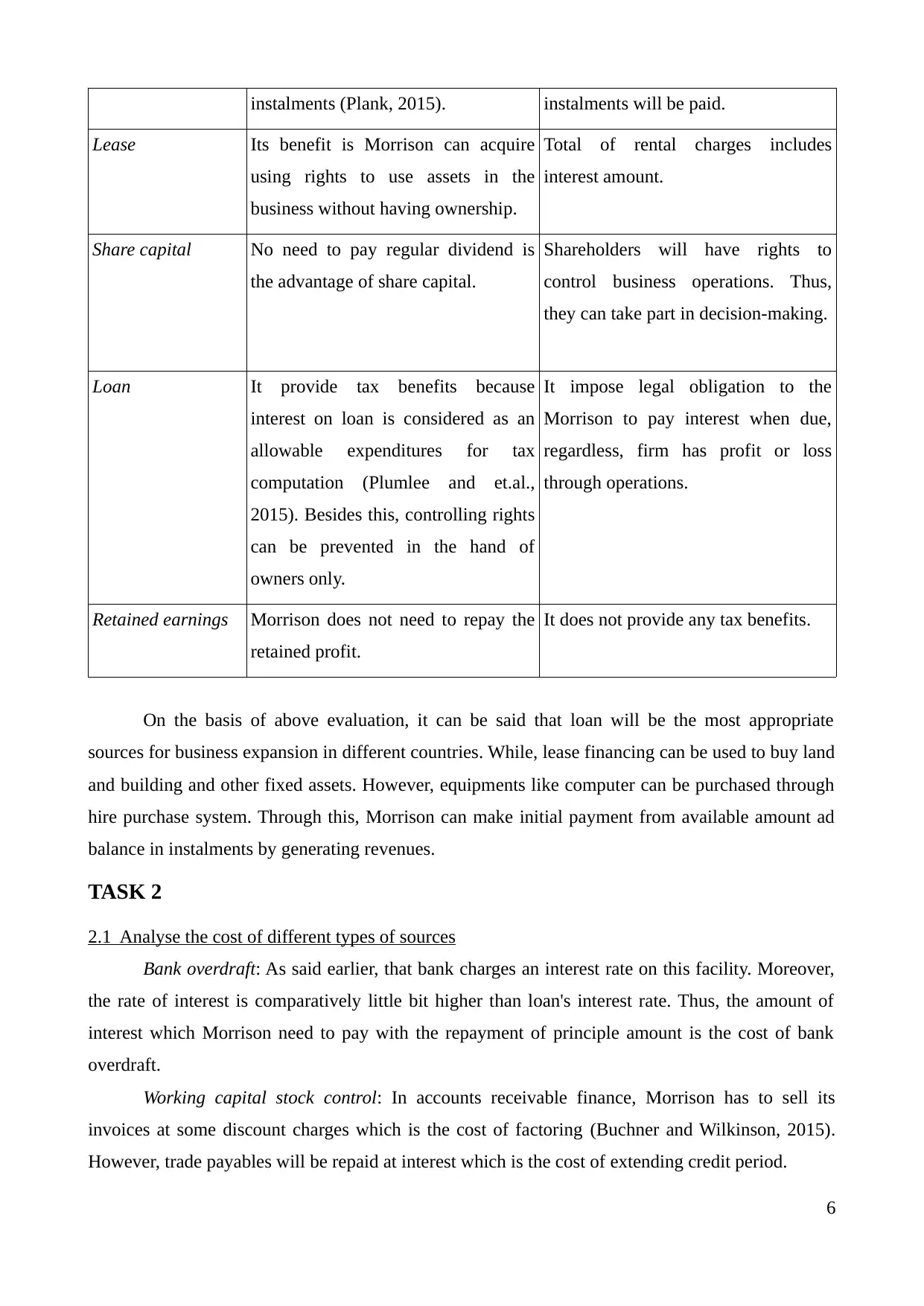
instalments (Plank, 2015). instalments will be paid.
Lease Its benefit is Morrison can acquire
using rights to use assets in the
business without having ownership.
Total of rental charges includes
interest amount.
Share capital No need to pay regular dividend is
the advantage of share capital.
Shareholders will have rights to
control business operations. Thus,
they can take part in decision-making.
Loan It provide tax benefits because
interest on loan is considered as an
allowable expenditures for tax
computation (Plumlee and et.al.,
2015). Besides this, controlling rights
can be prevented in the hand of
owners only.
It impose legal obligation to the
Morrison to pay interest when due,
regardless, firm has profit or loss
through operations.
Retained earnings Morrison does not need to repay the
retained profit.
It does not provide any tax benefits.
On the basis of above evaluation, it can be said that loan will be the most appropriate
sources for business expansion in different countries. While, lease financing can be used to buy land
and building and other fixed assets. However, equipments like computer can be purchased through
hire purchase system. Through this, Morrison can make initial payment from available amount ad
balance in instalments by generating revenues.
TASK 2
2.1 Analyse the cost of different types of sources
Bank overdraft: As said earlier, that bank charges an interest rate on this facility. Moreover,
the rate of interest is comparatively little bit higher than loan's interest rate. Thus, the amount of
interest which Morrison need to pay with the repayment of principle amount is the cost of bank
overdraft.
Working capital stock control: In accounts receivable finance, Morrison has to sell its
invoices at some discount charges which is the cost of factoring (Buchner and Wilkinson, 2015).
However, trade payables will be repaid at interest which is the cost of extending credit period.
6
Lease Its benefit is Morrison can acquire
using rights to use assets in the
business without having ownership.
Total of rental charges includes
interest amount.
Share capital No need to pay regular dividend is
the advantage of share capital.
Shareholders will have rights to
control business operations. Thus,
they can take part in decision-making.
Loan It provide tax benefits because
interest on loan is considered as an
allowable expenditures for tax
computation (Plumlee and et.al.,
2015). Besides this, controlling rights
can be prevented in the hand of
owners only.
It impose legal obligation to the
Morrison to pay interest when due,
regardless, firm has profit or loss
through operations.
Retained earnings Morrison does not need to repay the
retained profit.
It does not provide any tax benefits.
On the basis of above evaluation, it can be said that loan will be the most appropriate
sources for business expansion in different countries. While, lease financing can be used to buy land
and building and other fixed assets. However, equipments like computer can be purchased through
hire purchase system. Through this, Morrison can make initial payment from available amount ad
balance in instalments by generating revenues.
TASK 2
2.1 Analyse the cost of different types of sources
Bank overdraft: As said earlier, that bank charges an interest rate on this facility. Moreover,
the rate of interest is comparatively little bit higher than loan's interest rate. Thus, the amount of
interest which Morrison need to pay with the repayment of principle amount is the cost of bank
overdraft.
Working capital stock control: In accounts receivable finance, Morrison has to sell its
invoices at some discount charges which is the cost of factoring (Buchner and Wilkinson, 2015).
However, trade payables will be repaid at interest which is the cost of extending credit period.
6

Hire purchase: The remaining balance after making down payments will be paid in equal
instalments. This instalments includes some interest charges due to which, total payment exceeds
the buying price is known as cost of hire purchase.
Leasing: Regular rental charges need to be paid to use the assets of the owner. Lessor
include some amount of interest when deciding rental charges is the cost of getting assets on lease.
Share capital: Investors invest in the company so as to get maximum return on their equity.
Otherwise, they will sell their equity and invest in other organization (Lee, Sameen, and Cowling,
2015). Therefore, the return in the way of dividend and capital appreciation is the cost of share
capital. Moreover, shareholders also have right to control business operations. Besides this, cost of
printing shares, photocopy etc. are also the included in the cost.
Bank loan: Morrison will be liable to pay timely instalments with the interest charges as the
cost of debt funds. It also must be kept in mind that whether company will have profit or not, but it
will be obliged to pay instalments (Plumlee and et.al., 2015). Besides this, complying legal
formalities, stamp paper, collateral security to secure funds and guarantee also are the cost of loan.
Retained earnings: There is no financial cost of using retained profits because Morrison will
not need to pay back this amount but still, opportunity cost included in this. It refers to the profit
which Morrison can generate by investing retained income in any profitable investment.
2.2 Explain the importance of financial planning
Financial planning is an integral part of corporate planning through which Morrison can
make sensible financial decisions about their funds. With the assistance of this, Morrison's Certified
Financial Officer (CFO) can estimate required amount of capital which it will need to meet its
revenue and capital expenditures. Through this. CFO can frame strategic financial policies in order
to procurement, investment and effective administration of acquired funds (Altfest, 2016). It mainly
aims at deciding an optimum capital structure by the combination of both debt and equity capital.
Moreover, It focuses on effective utilization of the scare financial resources in the best possible
manner. So that, cost can be controlled and return can be maximized.
Importance of financial planning:
It assist Morrison to have adequate quantity of funds in the business to meet its financial
need timely.
Financial planning helps to maintain an effective balance between cash inflow and outflow
by ensuring maximum utilization of resources and enlarging revenue (Agarwal and et.al.,
2015).
It also helps Morrison to expand business operations in different market segments around
7
instalments. This instalments includes some interest charges due to which, total payment exceeds
the buying price is known as cost of hire purchase.
Leasing: Regular rental charges need to be paid to use the assets of the owner. Lessor
include some amount of interest when deciding rental charges is the cost of getting assets on lease.
Share capital: Investors invest in the company so as to get maximum return on their equity.
Otherwise, they will sell their equity and invest in other organization (Lee, Sameen, and Cowling,
2015). Therefore, the return in the way of dividend and capital appreciation is the cost of share
capital. Moreover, shareholders also have right to control business operations. Besides this, cost of
printing shares, photocopy etc. are also the included in the cost.
Bank loan: Morrison will be liable to pay timely instalments with the interest charges as the
cost of debt funds. It also must be kept in mind that whether company will have profit or not, but it
will be obliged to pay instalments (Plumlee and et.al., 2015). Besides this, complying legal
formalities, stamp paper, collateral security to secure funds and guarantee also are the cost of loan.
Retained earnings: There is no financial cost of using retained profits because Morrison will
not need to pay back this amount but still, opportunity cost included in this. It refers to the profit
which Morrison can generate by investing retained income in any profitable investment.
2.2 Explain the importance of financial planning
Financial planning is an integral part of corporate planning through which Morrison can
make sensible financial decisions about their funds. With the assistance of this, Morrison's Certified
Financial Officer (CFO) can estimate required amount of capital which it will need to meet its
revenue and capital expenditures. Through this. CFO can frame strategic financial policies in order
to procurement, investment and effective administration of acquired funds (Altfest, 2016). It mainly
aims at deciding an optimum capital structure by the combination of both debt and equity capital.
Moreover, It focuses on effective utilization of the scare financial resources in the best possible
manner. So that, cost can be controlled and return can be maximized.
Importance of financial planning:
It assist Morrison to have adequate quantity of funds in the business to meet its financial
need timely.
Financial planning helps to maintain an effective balance between cash inflow and outflow
by ensuring maximum utilization of resources and enlarging revenue (Agarwal and et.al.,
2015).
It also helps Morrison to expand business operations in different market segments around
7
Paraphrase This Document
Need a fresh take? Get an instant paraphrase of this document with our AI Paraphraser
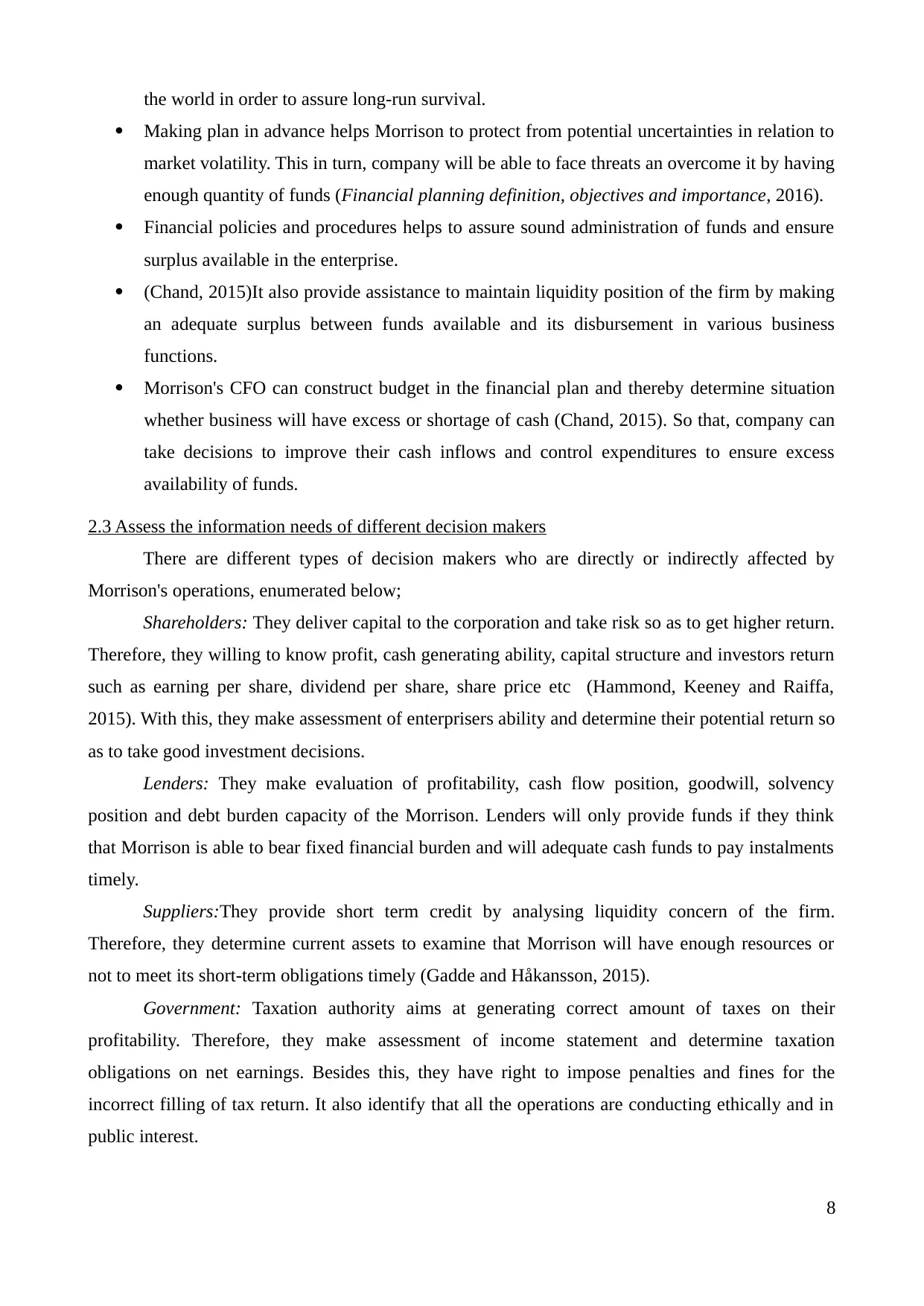
the world in order to assure long-run survival.
Making plan in advance helps Morrison to protect from potential uncertainties in relation to
market volatility. This in turn, company will be able to face threats an overcome it by having
enough quantity of funds (Financial planning definition, objectives and importance, 2016).
Financial policies and procedures helps to assure sound administration of funds and ensure
surplus available in the enterprise.
(Chand, 2015)It also provide assistance to maintain liquidity position of the firm by making
an adequate surplus between funds available and its disbursement in various business
functions.
Morrison's CFO can construct budget in the financial plan and thereby determine situation
whether business will have excess or shortage of cash (Chand, 2015). So that, company can
take decisions to improve their cash inflows and control expenditures to ensure excess
availability of funds.
2.3 Assess the information needs of different decision makers
There are different types of decision makers who are directly or indirectly affected by
Morrison's operations, enumerated below;
Shareholders: They deliver capital to the corporation and take risk so as to get higher return.
Therefore, they willing to know profit, cash generating ability, capital structure and investors return
such as earning per share, dividend per share, share price etc (Hammond, Keeney and Raiffa,
2015). With this, they make assessment of enterprisers ability and determine their potential return so
as to take good investment decisions.
Lenders: They make evaluation of profitability, cash flow position, goodwill, solvency
position and debt burden capacity of the Morrison. Lenders will only provide funds if they think
that Morrison is able to bear fixed financial burden and will adequate cash funds to pay instalments
timely.
Suppliers:They provide short term credit by analysing liquidity concern of the firm.
Therefore, they determine current assets to examine that Morrison will have enough resources or
not to meet its short-term obligations timely (Gadde and Håkansson, 2015).
Government: Taxation authority aims at generating correct amount of taxes on their
profitability. Therefore, they make assessment of income statement and determine taxation
obligations on net earnings. Besides this, they have right to impose penalties and fines for the
incorrect filling of tax return. It also identify that all the operations are conducting ethically and in
public interest.
8
Making plan in advance helps Morrison to protect from potential uncertainties in relation to
market volatility. This in turn, company will be able to face threats an overcome it by having
enough quantity of funds (Financial planning definition, objectives and importance, 2016).
Financial policies and procedures helps to assure sound administration of funds and ensure
surplus available in the enterprise.
(Chand, 2015)It also provide assistance to maintain liquidity position of the firm by making
an adequate surplus between funds available and its disbursement in various business
functions.
Morrison's CFO can construct budget in the financial plan and thereby determine situation
whether business will have excess or shortage of cash (Chand, 2015). So that, company can
take decisions to improve their cash inflows and control expenditures to ensure excess
availability of funds.
2.3 Assess the information needs of different decision makers
There are different types of decision makers who are directly or indirectly affected by
Morrison's operations, enumerated below;
Shareholders: They deliver capital to the corporation and take risk so as to get higher return.
Therefore, they willing to know profit, cash generating ability, capital structure and investors return
such as earning per share, dividend per share, share price etc (Hammond, Keeney and Raiffa,
2015). With this, they make assessment of enterprisers ability and determine their potential return so
as to take good investment decisions.
Lenders: They make evaluation of profitability, cash flow position, goodwill, solvency
position and debt burden capacity of the Morrison. Lenders will only provide funds if they think
that Morrison is able to bear fixed financial burden and will adequate cash funds to pay instalments
timely.
Suppliers:They provide short term credit by analysing liquidity concern of the firm.
Therefore, they determine current assets to examine that Morrison will have enough resources or
not to meet its short-term obligations timely (Gadde and Håkansson, 2015).
Government: Taxation authority aims at generating correct amount of taxes on their
profitability. Therefore, they make assessment of income statement and determine taxation
obligations on net earnings. Besides this, they have right to impose penalties and fines for the
incorrect filling of tax return. It also identify that all the operations are conducting ethically and in
public interest.
8

Managers: They are accountable to manage core business functioning by framing policies
and take effective decisions. Therefore, they analyse income, expenditures, profits, liquidity,
solvency, cash gathering ability and assets using efficiency (Hogan, Olson and Capella, 2015).
Employees: Workers are interested to get high salary, position, appraisal and non-monetary
rewards. Therefore, they make evaluation of business profitability and serve organization who have
good position and greater yield.
Public: Morrison operates in society therefore, company has certain responsibility towards
community. Public desire that corporations fulfil its environmental responsibility and respect all the
culture and religion of different community.
2.4 Explain the impact of finance on the financial statements
Bank Overdraft: In profitability statement, interest on overdraft will be shows on the debit
side as expenditure. While, in balance sheet, bank overdraft will be recorded as current liabilities
and include in cash balance in the head current assets. In addition, paid interest will be deducted
from the cash position.
Working capital: Discounted debtors through factoring will be subtracted from total debtors
in the current assets of Balance sheet and increase cash balance. While, creditors payments will
subtracted accounts payable and cash as well (Chand, 2015).
Hire purchase: In balance sheet, equipment will be shows as assets and instalments will be
recorded as expenditures in profitability statement and subtracted from cash balance as well.
Lease: Assets acquired will be shows as fixed assets in the balance sheet whereas periodic
rental charges will be reported as spendings in income statement and reduced available cash funds.
Share capital: Issued share capital will be reported as equity in the balance sheet and
improve cash position. While, dividend payment will be recorded in income statement as payment
and deducted from the cash balance in B/S (Buchner and Wilkinson, 2015)..
Loan: It will be recorded as non-current liability and improve cash balance in the current
assets head of B/S. However, in profitability statement, loan instalments will be shown as revenue
expenditures which decline business profit. Besides this, it will also subtracted from the cash
balance reported in B/S.
Retained earnings: It only changes the capital structure of the company therefore, it will be
reported in the statement of changes in equity and retained earnings (Plumlee and et.al., 2015).
TASK 3
3.1 Analyse budgets and make appropriate decisions
Cash budget is a budget that accumulates estimated cash inflow and outflow from different
9
and take effective decisions. Therefore, they analyse income, expenditures, profits, liquidity,
solvency, cash gathering ability and assets using efficiency (Hogan, Olson and Capella, 2015).
Employees: Workers are interested to get high salary, position, appraisal and non-monetary
rewards. Therefore, they make evaluation of business profitability and serve organization who have
good position and greater yield.
Public: Morrison operates in society therefore, company has certain responsibility towards
community. Public desire that corporations fulfil its environmental responsibility and respect all the
culture and religion of different community.
2.4 Explain the impact of finance on the financial statements
Bank Overdraft: In profitability statement, interest on overdraft will be shows on the debit
side as expenditure. While, in balance sheet, bank overdraft will be recorded as current liabilities
and include in cash balance in the head current assets. In addition, paid interest will be deducted
from the cash position.
Working capital: Discounted debtors through factoring will be subtracted from total debtors
in the current assets of Balance sheet and increase cash balance. While, creditors payments will
subtracted accounts payable and cash as well (Chand, 2015).
Hire purchase: In balance sheet, equipment will be shows as assets and instalments will be
recorded as expenditures in profitability statement and subtracted from cash balance as well.
Lease: Assets acquired will be shows as fixed assets in the balance sheet whereas periodic
rental charges will be reported as spendings in income statement and reduced available cash funds.
Share capital: Issued share capital will be reported as equity in the balance sheet and
improve cash position. While, dividend payment will be recorded in income statement as payment
and deducted from the cash balance in B/S (Buchner and Wilkinson, 2015)..
Loan: It will be recorded as non-current liability and improve cash balance in the current
assets head of B/S. However, in profitability statement, loan instalments will be shown as revenue
expenditures which decline business profit. Besides this, it will also subtracted from the cash
balance reported in B/S.
Retained earnings: It only changes the capital structure of the company therefore, it will be
reported in the statement of changes in equity and retained earnings (Plumlee and et.al., 2015).
TASK 3
3.1 Analyse budgets and make appropriate decisions
Cash budget is a budget that accumulates estimated cash inflow and outflow from different
9
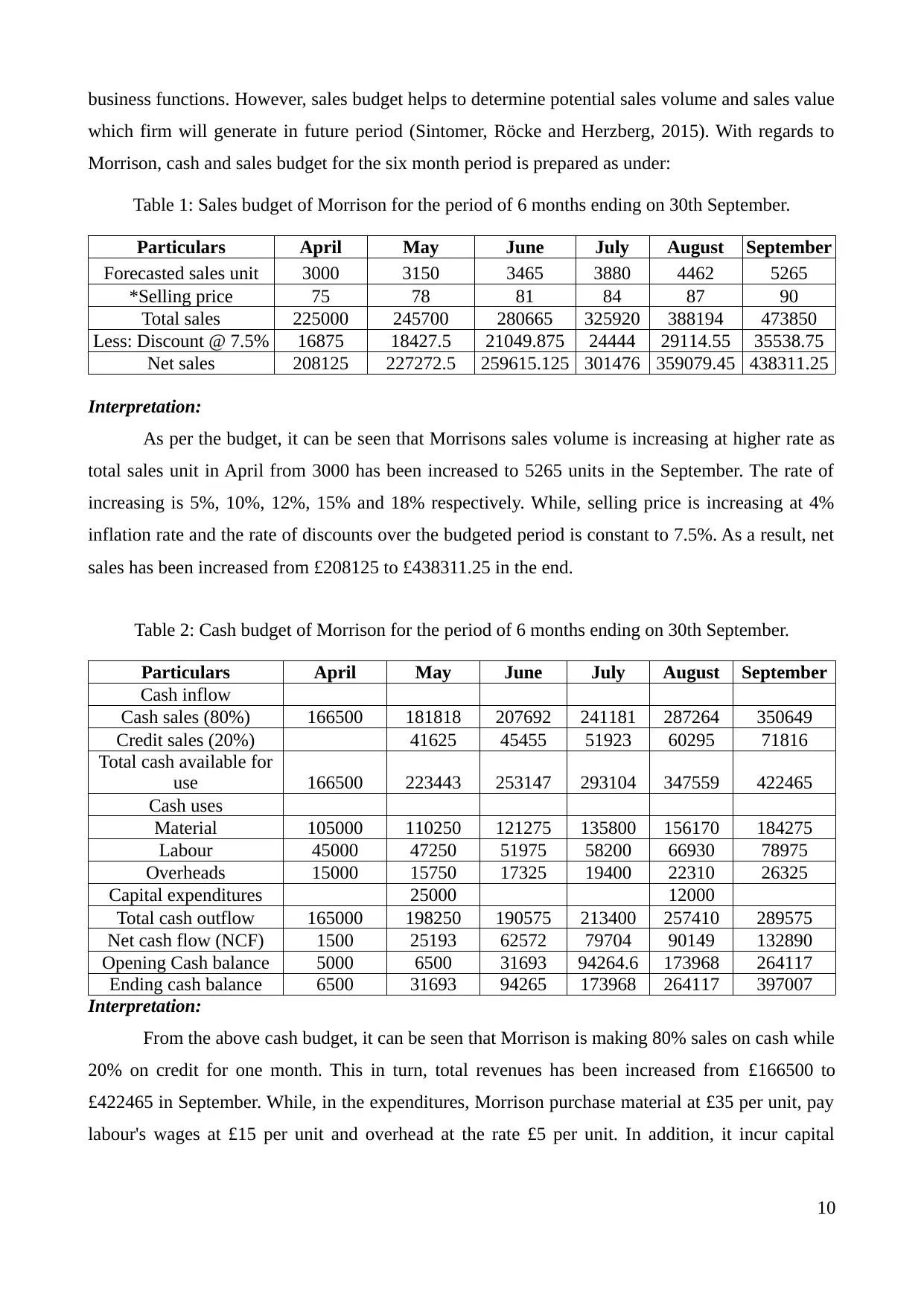
business functions. However, sales budget helps to determine potential sales volume and sales value
which firm will generate in future period (Sintomer, Röcke and Herzberg, 2015). With regards to
Morrison, cash and sales budget for the six month period is prepared as under:
Table 1: Sales budget of Morrison for the period of 6 months ending on 30th September.
Particulars April May June July August September
Forecasted sales unit 3000 3150 3465 3880 4462 5265
*Selling price 75 78 81 84 87 90
Total sales 225000 245700 280665 325920 388194 473850
Less: Discount @ 7.5% 16875 18427.5 21049.875 24444 29114.55 35538.75
Net sales 208125 227272.5 259615.125 301476 359079.45 438311.25
Interpretation:
As per the budget, it can be seen that Morrisons sales volume is increasing at higher rate as
total sales unit in April from 3000 has been increased to 5265 units in the September. The rate of
increasing is 5%, 10%, 12%, 15% and 18% respectively. While, selling price is increasing at 4%
inflation rate and the rate of discounts over the budgeted period is constant to 7.5%. As a result, net
sales has been increased from £208125 to £438311.25 in the end.
Table 2: Cash budget of Morrison for the period of 6 months ending on 30th September.
Particulars April May June July August September
Cash inflow
Cash sales (80%) 166500 181818 207692 241181 287264 350649
Credit sales (20%) 41625 45455 51923 60295 71816
Total cash available for
use 166500 223443 253147 293104 347559 422465
Cash uses
Material 105000 110250 121275 135800 156170 184275
Labour 45000 47250 51975 58200 66930 78975
Overheads 15000 15750 17325 19400 22310 26325
Capital expenditures 25000 12000
Total cash outflow 165000 198250 190575 213400 257410 289575
Net cash flow (NCF) 1500 25193 62572 79704 90149 132890
Opening Cash balance 5000 6500 31693 94264.6 173968 264117
Ending cash balance 6500 31693 94265 173968 264117 397007
Interpretation:
From the above cash budget, it can be seen that Morrison is making 80% sales on cash while
20% on credit for one month. This in turn, total revenues has been increased from £166500 to
£422465 in September. While, in the expenditures, Morrison purchase material at £35 per unit, pay
labour's wages at £15 per unit and overhead at the rate £5 per unit. In addition, it incur capital
10
which firm will generate in future period (Sintomer, Röcke and Herzberg, 2015). With regards to
Morrison, cash and sales budget for the six month period is prepared as under:
Table 1: Sales budget of Morrison for the period of 6 months ending on 30th September.
Particulars April May June July August September
Forecasted sales unit 3000 3150 3465 3880 4462 5265
*Selling price 75 78 81 84 87 90
Total sales 225000 245700 280665 325920 388194 473850
Less: Discount @ 7.5% 16875 18427.5 21049.875 24444 29114.55 35538.75
Net sales 208125 227272.5 259615.125 301476 359079.45 438311.25
Interpretation:
As per the budget, it can be seen that Morrisons sales volume is increasing at higher rate as
total sales unit in April from 3000 has been increased to 5265 units in the September. The rate of
increasing is 5%, 10%, 12%, 15% and 18% respectively. While, selling price is increasing at 4%
inflation rate and the rate of discounts over the budgeted period is constant to 7.5%. As a result, net
sales has been increased from £208125 to £438311.25 in the end.
Table 2: Cash budget of Morrison for the period of 6 months ending on 30th September.
Particulars April May June July August September
Cash inflow
Cash sales (80%) 166500 181818 207692 241181 287264 350649
Credit sales (20%) 41625 45455 51923 60295 71816
Total cash available for
use 166500 223443 253147 293104 347559 422465
Cash uses
Material 105000 110250 121275 135800 156170 184275
Labour 45000 47250 51975 58200 66930 78975
Overheads 15000 15750 17325 19400 22310 26325
Capital expenditures 25000 12000
Total cash outflow 165000 198250 190575 213400 257410 289575
Net cash flow (NCF) 1500 25193 62572 79704 90149 132890
Opening Cash balance 5000 6500 31693 94264.6 173968 264117
Ending cash balance 6500 31693 94265 173968 264117 397007
Interpretation:
From the above cash budget, it can be seen that Morrison is making 80% sales on cash while
20% on credit for one month. This in turn, total revenues has been increased from £166500 to
£422465 in September. While, in the expenditures, Morrison purchase material at £35 per unit, pay
labour's wages at £15 per unit and overhead at the rate £5 per unit. In addition, it incur capital
10
Secure Best Marks with AI Grader
Need help grading? Try our AI Grader for instant feedback on your assignments.
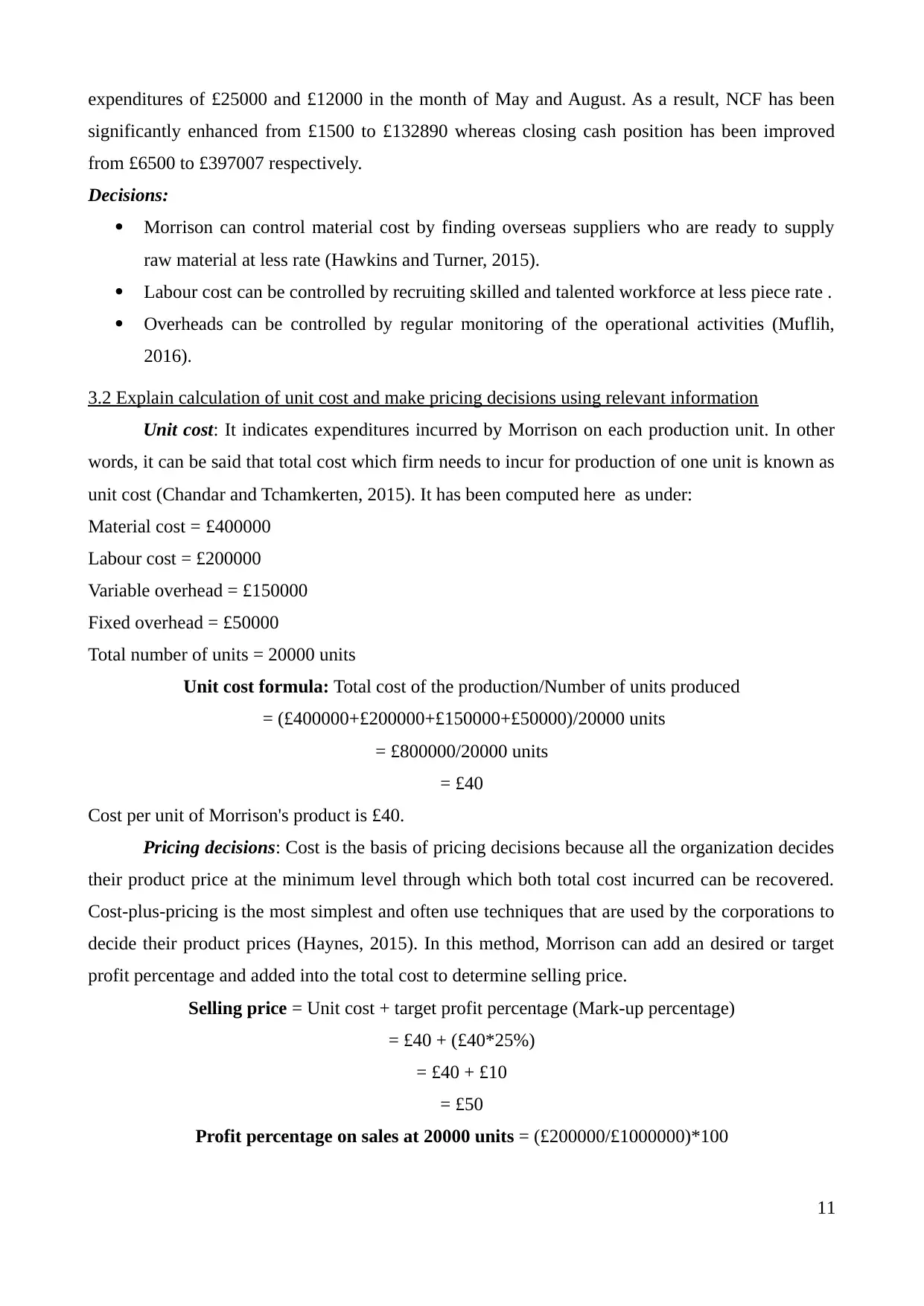
expenditures of £25000 and £12000 in the month of May and August. As a result, NCF has been
significantly enhanced from £1500 to £132890 whereas closing cash position has been improved
from £6500 to £397007 respectively.
Decisions:
Morrison can control material cost by finding overseas suppliers who are ready to supply
raw material at less rate (Hawkins and Turner, 2015).
Labour cost can be controlled by recruiting skilled and talented workforce at less piece rate .
Overheads can be controlled by regular monitoring of the operational activities (Muflih,
2016).
3.2 Explain calculation of unit cost and make pricing decisions using relevant information
Unit cost: It indicates expenditures incurred by Morrison on each production unit. In other
words, it can be said that total cost which firm needs to incur for production of one unit is known as
unit cost (Chandar and Tchamkerten, 2015). It has been computed here as under:
Material cost = £400000
Labour cost = £200000
Variable overhead = £150000
Fixed overhead = £50000
Total number of units = 20000 units
Unit cost formula: Total cost of the production/Number of units produced
= (£400000+£200000+£150000+£50000)/20000 units
= £800000/20000 units
= £40
Cost per unit of Morrison's product is £40.
Pricing decisions: Cost is the basis of pricing decisions because all the organization decides
their product price at the minimum level through which both total cost incurred can be recovered.
Cost-plus-pricing is the most simplest and often use techniques that are used by the corporations to
decide their product prices (Haynes, 2015). In this method, Morrison can add an desired or target
profit percentage and added into the total cost to determine selling price.
Selling price = Unit cost + target profit percentage (Mark-up percentage)
= £40 + (£40*25%)
= £40 + £10
= £50
Profit percentage on sales at 20000 units = (£200000/£1000000)*100
11
significantly enhanced from £1500 to £132890 whereas closing cash position has been improved
from £6500 to £397007 respectively.
Decisions:
Morrison can control material cost by finding overseas suppliers who are ready to supply
raw material at less rate (Hawkins and Turner, 2015).
Labour cost can be controlled by recruiting skilled and talented workforce at less piece rate .
Overheads can be controlled by regular monitoring of the operational activities (Muflih,
2016).
3.2 Explain calculation of unit cost and make pricing decisions using relevant information
Unit cost: It indicates expenditures incurred by Morrison on each production unit. In other
words, it can be said that total cost which firm needs to incur for production of one unit is known as
unit cost (Chandar and Tchamkerten, 2015). It has been computed here as under:
Material cost = £400000
Labour cost = £200000
Variable overhead = £150000
Fixed overhead = £50000
Total number of units = 20000 units
Unit cost formula: Total cost of the production/Number of units produced
= (£400000+£200000+£150000+£50000)/20000 units
= £800000/20000 units
= £40
Cost per unit of Morrison's product is £40.
Pricing decisions: Cost is the basis of pricing decisions because all the organization decides
their product price at the minimum level through which both total cost incurred can be recovered.
Cost-plus-pricing is the most simplest and often use techniques that are used by the corporations to
decide their product prices (Haynes, 2015). In this method, Morrison can add an desired or target
profit percentage and added into the total cost to determine selling price.
Selling price = Unit cost + target profit percentage (Mark-up percentage)
= £40 + (£40*25%)
= £40 + £10
= £50
Profit percentage on sales at 20000 units = (£200000/£1000000)*100
11
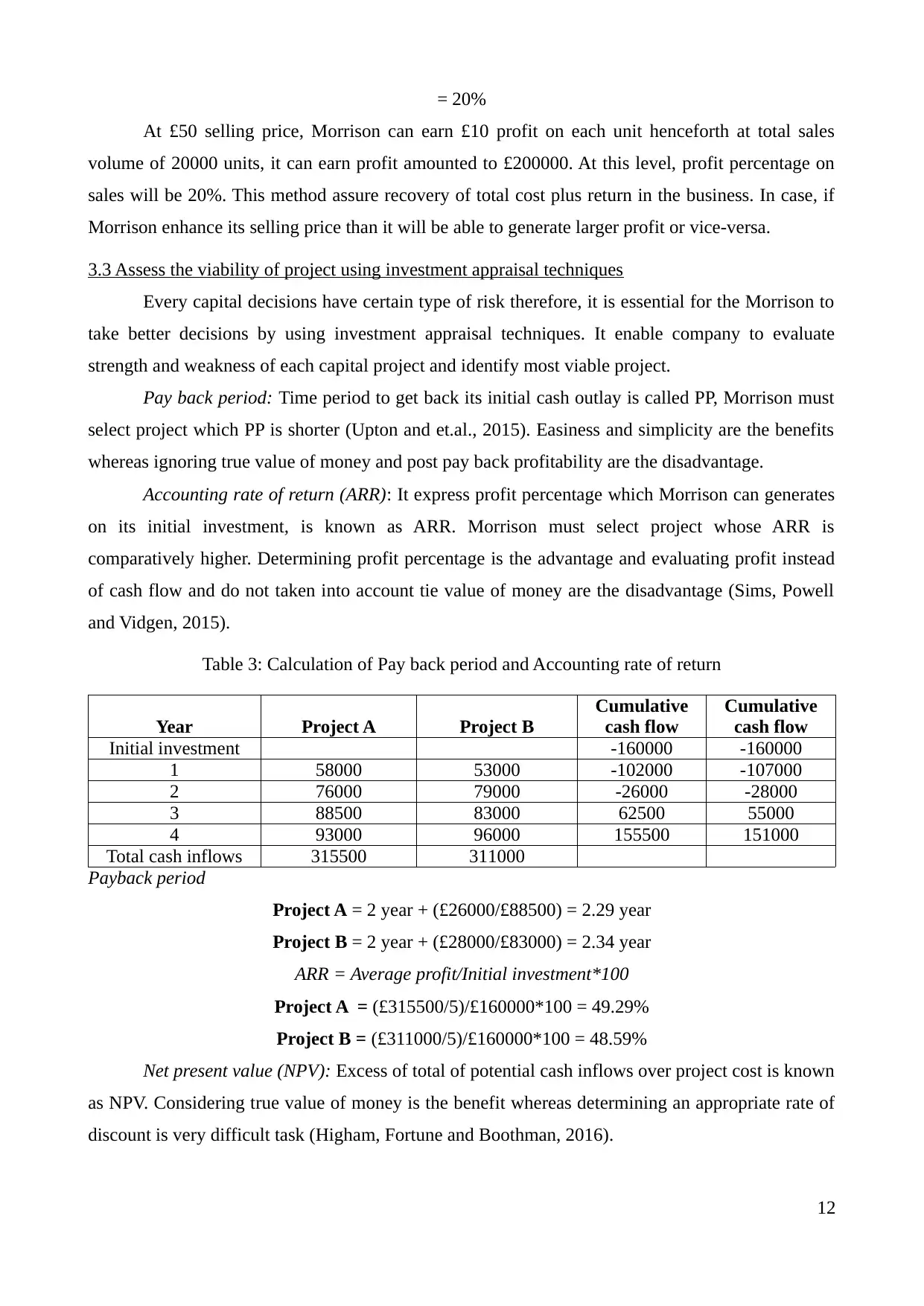
= 20%
At £50 selling price, Morrison can earn £10 profit on each unit henceforth at total sales
volume of 20000 units, it can earn profit amounted to £200000. At this level, profit percentage on
sales will be 20%. This method assure recovery of total cost plus return in the business. In case, if
Morrison enhance its selling price than it will be able to generate larger profit or vice-versa.
3.3 Assess the viability of project using investment appraisal techniques
Every capital decisions have certain type of risk therefore, it is essential for the Morrison to
take better decisions by using investment appraisal techniques. It enable company to evaluate
strength and weakness of each capital project and identify most viable project.
Pay back period: Time period to get back its initial cash outlay is called PP, Morrison must
select project which PP is shorter (Upton and et.al., 2015). Easiness and simplicity are the benefits
whereas ignoring true value of money and post pay back profitability are the disadvantage.
Accounting rate of return (ARR): It express profit percentage which Morrison can generates
on its initial investment, is known as ARR. Morrison must select project whose ARR is
comparatively higher. Determining profit percentage is the advantage and evaluating profit instead
of cash flow and do not taken into account tie value of money are the disadvantage (Sims, Powell
and Vidgen, 2015).
Table 3: Calculation of Pay back period and Accounting rate of return
Year Project A Project B
Cumulative
cash flow
Cumulative
cash flow
Initial investment -160000 -160000
1 58000 53000 -102000 -107000
2 76000 79000 -26000 -28000
3 88500 83000 62500 55000
4 93000 96000 155500 151000
Total cash inflows 315500 311000
Payback period
Project A = 2 year + (£26000/£88500) = 2.29 year
Project B = 2 year + (£28000/£83000) = 2.34 year
ARR = Average profit/Initial investment*100
Project A = (£315500/5)/£160000*100 = 49.29%
Project B = (£311000/5)/£160000*100 = 48.59%
Net present value (NPV): Excess of total of potential cash inflows over project cost is known
as NPV. Considering true value of money is the benefit whereas determining an appropriate rate of
discount is very difficult task (Higham, Fortune and Boothman, 2016).
12
At £50 selling price, Morrison can earn £10 profit on each unit henceforth at total sales
volume of 20000 units, it can earn profit amounted to £200000. At this level, profit percentage on
sales will be 20%. This method assure recovery of total cost plus return in the business. In case, if
Morrison enhance its selling price than it will be able to generate larger profit or vice-versa.
3.3 Assess the viability of project using investment appraisal techniques
Every capital decisions have certain type of risk therefore, it is essential for the Morrison to
take better decisions by using investment appraisal techniques. It enable company to evaluate
strength and weakness of each capital project and identify most viable project.
Pay back period: Time period to get back its initial cash outlay is called PP, Morrison must
select project which PP is shorter (Upton and et.al., 2015). Easiness and simplicity are the benefits
whereas ignoring true value of money and post pay back profitability are the disadvantage.
Accounting rate of return (ARR): It express profit percentage which Morrison can generates
on its initial investment, is known as ARR. Morrison must select project whose ARR is
comparatively higher. Determining profit percentage is the advantage and evaluating profit instead
of cash flow and do not taken into account tie value of money are the disadvantage (Sims, Powell
and Vidgen, 2015).
Table 3: Calculation of Pay back period and Accounting rate of return
Year Project A Project B
Cumulative
cash flow
Cumulative
cash flow
Initial investment -160000 -160000
1 58000 53000 -102000 -107000
2 76000 79000 -26000 -28000
3 88500 83000 62500 55000
4 93000 96000 155500 151000
Total cash inflows 315500 311000
Payback period
Project A = 2 year + (£26000/£88500) = 2.29 year
Project B = 2 year + (£28000/£83000) = 2.34 year
ARR = Average profit/Initial investment*100
Project A = (£315500/5)/£160000*100 = 49.29%
Project B = (£311000/5)/£160000*100 = 48.59%
Net present value (NPV): Excess of total of potential cash inflows over project cost is known
as NPV. Considering true value of money is the benefit whereas determining an appropriate rate of
discount is very difficult task (Higham, Fortune and Boothman, 2016).
12

Internal rate of return (IRR): The discounting rate at which project will not generate any
NPV is called IRR. Taking into account time value of money is the advantage whilst sometimes
contradicting results of NPV and IRR makes it difficult to chose viable project (Turner, 2016).
Table 4: Calculation of NPV and IRR
Year Project A Project B DV @ 10% DCF DCF
Initial investment -160000 -160000 1 -160000 -160000
1 58000 53000 0.9091 52727.27 48181.82
2 76000 79000 0.8264 62809.92 65289.26
3 88500 83000 0.7513 66491.36 62359.13
4 93000 96000 0.6830 63520.25 65569.29
IRR 30.83% 29.63% NPV 85548.80 81399.49
Interpretation:
Taken into account the results, it should be suggested to management that Morrison should
invest funds in project A because it will recover initial investment worth £160000 earlier in 2.29
year. Moreover, high ARR of 49.29%, IRR of 30.83% and NPV of £85548.80 demonstrates that
project A is more viable as compare to project B.
TASK 4
4.1 Discuss the main financial statements
Morrison has to prepare different financial statement to measure its performance during the
accounting period. Three main financial statements which Morrison prepare are enumerated below:
Statement of comprehensive income (SOCI): This statement accumulates all the collected
revenues and incurred expenditures in the given period. Income includes sales whilst spendings
comprises purchase, rent, insurance, electricity, wages, salary, dividend, depreciation etc. The main
objective of SOCI is to determine business results in the terms of profit (excess of revenue over
expenses) or loss (excess of spendings over income) (Fraser and Ormiston, 2015). SOCI is prepared
by following accrual accounting concept thus, all the historical transactions whether cash or credit
are compiled.
Statement of financial position (SOFP): It is also known as balance sheet which can be
prepared by taking into account assets and liabilities available at the end of financial year. Assets
include fixed (property, plant, land and building etc.) and current assets (receivables, inventory, cash
etc.). However, liabilities includes current (trade payables, overdraft, provisions etc.) and long term
liabilities (debentures, bank loan etc.). Morrison prepare SOFP to measure financial position of the
company.
Statement of cash flow (SOCF): It includes cash inflow and its disbursement through
13
NPV is called IRR. Taking into account time value of money is the advantage whilst sometimes
contradicting results of NPV and IRR makes it difficult to chose viable project (Turner, 2016).
Table 4: Calculation of NPV and IRR
Year Project A Project B DV @ 10% DCF DCF
Initial investment -160000 -160000 1 -160000 -160000
1 58000 53000 0.9091 52727.27 48181.82
2 76000 79000 0.8264 62809.92 65289.26
3 88500 83000 0.7513 66491.36 62359.13
4 93000 96000 0.6830 63520.25 65569.29
IRR 30.83% 29.63% NPV 85548.80 81399.49
Interpretation:
Taken into account the results, it should be suggested to management that Morrison should
invest funds in project A because it will recover initial investment worth £160000 earlier in 2.29
year. Moreover, high ARR of 49.29%, IRR of 30.83% and NPV of £85548.80 demonstrates that
project A is more viable as compare to project B.
TASK 4
4.1 Discuss the main financial statements
Morrison has to prepare different financial statement to measure its performance during the
accounting period. Three main financial statements which Morrison prepare are enumerated below:
Statement of comprehensive income (SOCI): This statement accumulates all the collected
revenues and incurred expenditures in the given period. Income includes sales whilst spendings
comprises purchase, rent, insurance, electricity, wages, salary, dividend, depreciation etc. The main
objective of SOCI is to determine business results in the terms of profit (excess of revenue over
expenses) or loss (excess of spendings over income) (Fraser and Ormiston, 2015). SOCI is prepared
by following accrual accounting concept thus, all the historical transactions whether cash or credit
are compiled.
Statement of financial position (SOFP): It is also known as balance sheet which can be
prepared by taking into account assets and liabilities available at the end of financial year. Assets
include fixed (property, plant, land and building etc.) and current assets (receivables, inventory, cash
etc.). However, liabilities includes current (trade payables, overdraft, provisions etc.) and long term
liabilities (debentures, bank loan etc.). Morrison prepare SOFP to measure financial position of the
company.
Statement of cash flow (SOCF): It includes cash inflow and its disbursement through
13
Paraphrase This Document
Need a fresh take? Get an instant paraphrase of this document with our AI Paraphraser
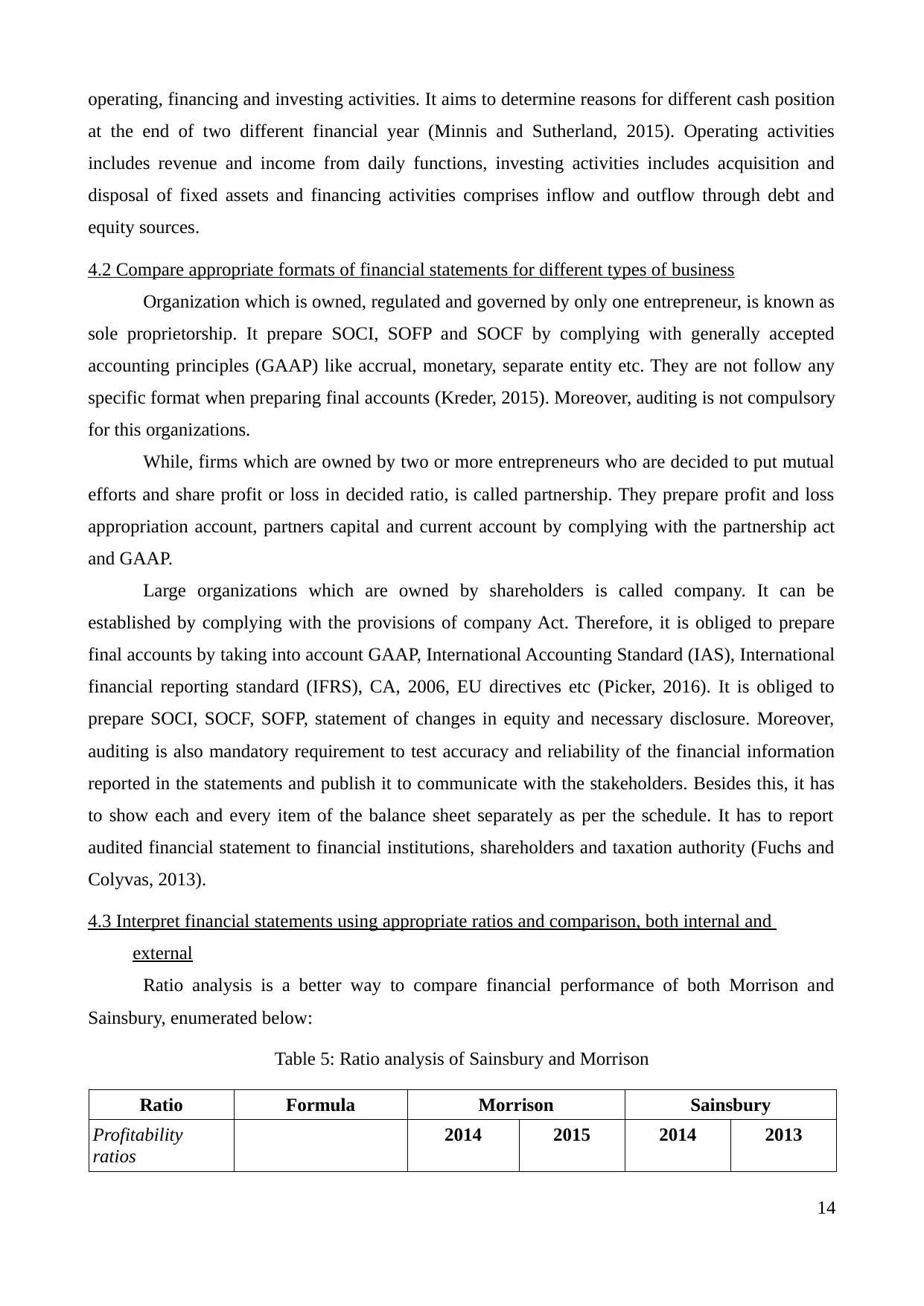
operating, financing and investing activities. It aims to determine reasons for different cash position
at the end of two different financial year (Minnis and Sutherland, 2015). Operating activities
includes revenue and income from daily functions, investing activities includes acquisition and
disposal of fixed assets and financing activities comprises inflow and outflow through debt and
equity sources.
4.2 Compare appropriate formats of financial statements for different types of business
Organization which is owned, regulated and governed by only one entrepreneur, is known as
sole proprietorship. It prepare SOCI, SOFP and SOCF by complying with generally accepted
accounting principles (GAAP) like accrual, monetary, separate entity etc. They are not follow any
specific format when preparing final accounts (Kreder, 2015). Moreover, auditing is not compulsory
for this organizations.
While, firms which are owned by two or more entrepreneurs who are decided to put mutual
efforts and share profit or loss in decided ratio, is called partnership. They prepare profit and loss
appropriation account, partners capital and current account by complying with the partnership act
and GAAP.
Large organizations which are owned by shareholders is called company. It can be
established by complying with the provisions of company Act. Therefore, it is obliged to prepare
final accounts by taking into account GAAP, International Accounting Standard (IAS), International
financial reporting standard (IFRS), CA, 2006, EU directives etc (Picker, 2016). It is obliged to
prepare SOCI, SOCF, SOFP, statement of changes in equity and necessary disclosure. Moreover,
auditing is also mandatory requirement to test accuracy and reliability of the financial information
reported in the statements and publish it to communicate with the stakeholders. Besides this, it has
to show each and every item of the balance sheet separately as per the schedule. It has to report
audited financial statement to financial institutions, shareholders and taxation authority (Fuchs and
Colyvas, 2013).
4.3 Interpret financial statements using appropriate ratios and comparison, both internal and
external
Ratio analysis is a better way to compare financial performance of both Morrison and
Sainsbury, enumerated below:
Table 5: Ratio analysis of Sainsbury and Morrison
Ratio Formula Morrison Sainsbury
Profitability
ratios
2014 2015 2014 2013
14
at the end of two different financial year (Minnis and Sutherland, 2015). Operating activities
includes revenue and income from daily functions, investing activities includes acquisition and
disposal of fixed assets and financing activities comprises inflow and outflow through debt and
equity sources.
4.2 Compare appropriate formats of financial statements for different types of business
Organization which is owned, regulated and governed by only one entrepreneur, is known as
sole proprietorship. It prepare SOCI, SOFP and SOCF by complying with generally accepted
accounting principles (GAAP) like accrual, monetary, separate entity etc. They are not follow any
specific format when preparing final accounts (Kreder, 2015). Moreover, auditing is not compulsory
for this organizations.
While, firms which are owned by two or more entrepreneurs who are decided to put mutual
efforts and share profit or loss in decided ratio, is called partnership. They prepare profit and loss
appropriation account, partners capital and current account by complying with the partnership act
and GAAP.
Large organizations which are owned by shareholders is called company. It can be
established by complying with the provisions of company Act. Therefore, it is obliged to prepare
final accounts by taking into account GAAP, International Accounting Standard (IAS), International
financial reporting standard (IFRS), CA, 2006, EU directives etc (Picker, 2016). It is obliged to
prepare SOCI, SOCF, SOFP, statement of changes in equity and necessary disclosure. Moreover,
auditing is also mandatory requirement to test accuracy and reliability of the financial information
reported in the statements and publish it to communicate with the stakeholders. Besides this, it has
to show each and every item of the balance sheet separately as per the schedule. It has to report
audited financial statement to financial institutions, shareholders and taxation authority (Fuchs and
Colyvas, 2013).
4.3 Interpret financial statements using appropriate ratios and comparison, both internal and
external
Ratio analysis is a better way to compare financial performance of both Morrison and
Sainsbury, enumerated below:
Table 5: Ratio analysis of Sainsbury and Morrison
Ratio Formula Morrison Sainsbury
Profitability
ratios
2014 2015 2014 2013
14
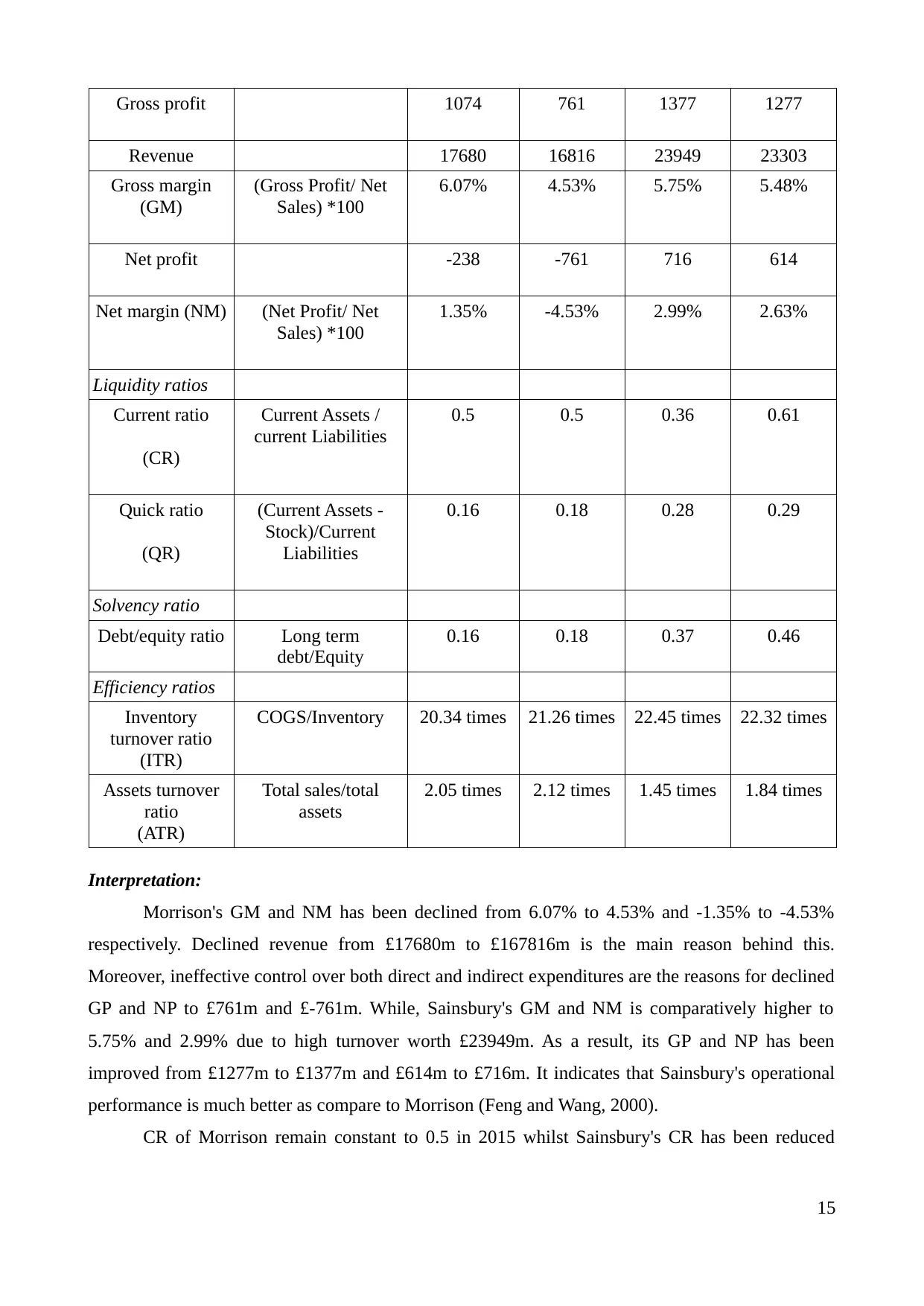
Gross profit 1074 761 1377 1277
Revenue 17680 16816 23949 23303
Gross margin
(GM)
(Gross Profit/ Net
Sales) *100
6.07% 4.53% 5.75% 5.48%
Net profit -238 -761 716 614
Net margin (NM) (Net Profit/ Net
Sales) *100
1.35% -4.53% 2.99% 2.63%
Liquidity ratios
Current ratio
(CR)
Current Assets /
current Liabilities
0.5 0.5 0.36 0.61
Quick ratio
(QR)
(Current Assets -
Stock)/Current
Liabilities
0.16 0.18 0.28 0.29
Solvency ratio
Debt/equity ratio Long term
debt/Equity
0.16 0.18 0.37 0.46
Efficiency ratios
Inventory
turnover ratio
(ITR)
COGS/Inventory 20.34 times 21.26 times 22.45 times 22.32 times
Assets turnover
ratio
(ATR)
Total sales/total
assets
2.05 times 2.12 times 1.45 times 1.84 times
Interpretation:
Morrison's GM and NM has been declined from 6.07% to 4.53% and -1.35% to -4.53%
respectively. Declined revenue from £17680m to £167816m is the main reason behind this.
Moreover, ineffective control over both direct and indirect expenditures are the reasons for declined
GP and NP to £761m and £-761m. While, Sainsbury's GM and NM is comparatively higher to
5.75% and 2.99% due to high turnover worth £23949m. As a result, its GP and NP has been
improved from £1277m to £1377m and £614m to £716m. It indicates that Sainsbury's operational
performance is much better as compare to Morrison (Feng and Wang, 2000).
CR of Morrison remain constant to 0.5 in 2015 whilst Sainsbury's CR has been reduced
15
Revenue 17680 16816 23949 23303
Gross margin
(GM)
(Gross Profit/ Net
Sales) *100
6.07% 4.53% 5.75% 5.48%
Net profit -238 -761 716 614
Net margin (NM) (Net Profit/ Net
Sales) *100
1.35% -4.53% 2.99% 2.63%
Liquidity ratios
Current ratio
(CR)
Current Assets /
current Liabilities
0.5 0.5 0.36 0.61
Quick ratio
(QR)
(Current Assets -
Stock)/Current
Liabilities
0.16 0.18 0.28 0.29
Solvency ratio
Debt/equity ratio Long term
debt/Equity
0.16 0.18 0.37 0.46
Efficiency ratios
Inventory
turnover ratio
(ITR)
COGS/Inventory 20.34 times 21.26 times 22.45 times 22.32 times
Assets turnover
ratio
(ATR)
Total sales/total
assets
2.05 times 2.12 times 1.45 times 1.84 times
Interpretation:
Morrison's GM and NM has been declined from 6.07% to 4.53% and -1.35% to -4.53%
respectively. Declined revenue from £17680m to £167816m is the main reason behind this.
Moreover, ineffective control over both direct and indirect expenditures are the reasons for declined
GP and NP to £761m and £-761m. While, Sainsbury's GM and NM is comparatively higher to
5.75% and 2.99% due to high turnover worth £23949m. As a result, its GP and NP has been
improved from £1277m to £1377m and £614m to £716m. It indicates that Sainsbury's operational
performance is much better as compare to Morrison (Feng and Wang, 2000).
CR of Morrison remain constant to 0.5 in 2015 whilst Sainsbury's CR has been reduced
15
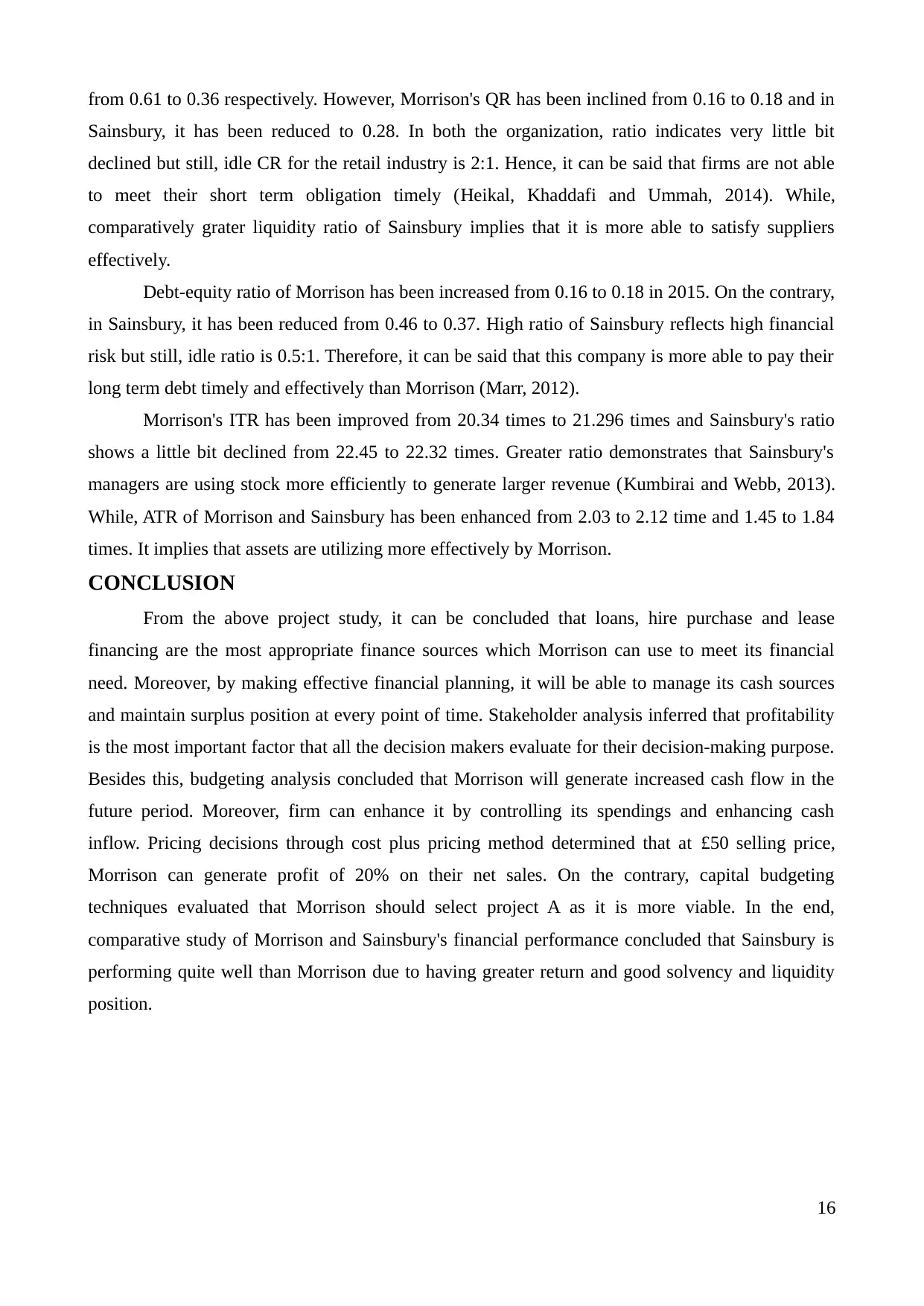
from 0.61 to 0.36 respectively. However, Morrison's QR has been inclined from 0.16 to 0.18 and in
Sainsbury, it has been reduced to 0.28. In both the organization, ratio indicates very little bit
declined but still, idle CR for the retail industry is 2:1. Hence, it can be said that firms are not able
to meet their short term obligation timely (Heikal, Khaddafi and Ummah, 2014). While,
comparatively grater liquidity ratio of Sainsbury implies that it is more able to satisfy suppliers
effectively.
Debt-equity ratio of Morrison has been increased from 0.16 to 0.18 in 2015. On the contrary,
in Sainsbury, it has been reduced from 0.46 to 0.37. High ratio of Sainsbury reflects high financial
risk but still, idle ratio is 0.5:1. Therefore, it can be said that this company is more able to pay their
long term debt timely and effectively than Morrison (Marr, 2012).
Morrison's ITR has been improved from 20.34 times to 21.296 times and Sainsbury's ratio
shows a little bit declined from 22.45 to 22.32 times. Greater ratio demonstrates that Sainsbury's
managers are using stock more efficiently to generate larger revenue (Kumbirai and Webb, 2013).
While, ATR of Morrison and Sainsbury has been enhanced from 2.03 to 2.12 time and 1.45 to 1.84
times. It implies that assets are utilizing more effectively by Morrison.
CONCLUSION
From the above project study, it can be concluded that loans, hire purchase and lease
financing are the most appropriate finance sources which Morrison can use to meet its financial
need. Moreover, by making effective financial planning, it will be able to manage its cash sources
and maintain surplus position at every point of time. Stakeholder analysis inferred that profitability
is the most important factor that all the decision makers evaluate for their decision-making purpose.
Besides this, budgeting analysis concluded that Morrison will generate increased cash flow in the
future period. Moreover, firm can enhance it by controlling its spendings and enhancing cash
inflow. Pricing decisions through cost plus pricing method determined that at £50 selling price,
Morrison can generate profit of 20% on their net sales. On the contrary, capital budgeting
techniques evaluated that Morrison should select project A as it is more viable. In the end,
comparative study of Morrison and Sainsbury's financial performance concluded that Sainsbury is
performing quite well than Morrison due to having greater return and good solvency and liquidity
position.
16
Sainsbury, it has been reduced to 0.28. In both the organization, ratio indicates very little bit
declined but still, idle CR for the retail industry is 2:1. Hence, it can be said that firms are not able
to meet their short term obligation timely (Heikal, Khaddafi and Ummah, 2014). While,
comparatively grater liquidity ratio of Sainsbury implies that it is more able to satisfy suppliers
effectively.
Debt-equity ratio of Morrison has been increased from 0.16 to 0.18 in 2015. On the contrary,
in Sainsbury, it has been reduced from 0.46 to 0.37. High ratio of Sainsbury reflects high financial
risk but still, idle ratio is 0.5:1. Therefore, it can be said that this company is more able to pay their
long term debt timely and effectively than Morrison (Marr, 2012).
Morrison's ITR has been improved from 20.34 times to 21.296 times and Sainsbury's ratio
shows a little bit declined from 22.45 to 22.32 times. Greater ratio demonstrates that Sainsbury's
managers are using stock more efficiently to generate larger revenue (Kumbirai and Webb, 2013).
While, ATR of Morrison and Sainsbury has been enhanced from 2.03 to 2.12 time and 1.45 to 1.84
times. It implies that assets are utilizing more effectively by Morrison.
CONCLUSION
From the above project study, it can be concluded that loans, hire purchase and lease
financing are the most appropriate finance sources which Morrison can use to meet its financial
need. Moreover, by making effective financial planning, it will be able to manage its cash sources
and maintain surplus position at every point of time. Stakeholder analysis inferred that profitability
is the most important factor that all the decision makers evaluate for their decision-making purpose.
Besides this, budgeting analysis concluded that Morrison will generate increased cash flow in the
future period. Moreover, firm can enhance it by controlling its spendings and enhancing cash
inflow. Pricing decisions through cost plus pricing method determined that at £50 selling price,
Morrison can generate profit of 20% on their net sales. On the contrary, capital budgeting
techniques evaluated that Morrison should select project A as it is more viable. In the end,
comparative study of Morrison and Sainsbury's financial performance concluded that Sainsbury is
performing quite well than Morrison due to having greater return and good solvency and liquidity
position.
16
Secure Best Marks with AI Grader
Need help grading? Try our AI Grader for instant feedback on your assignments.
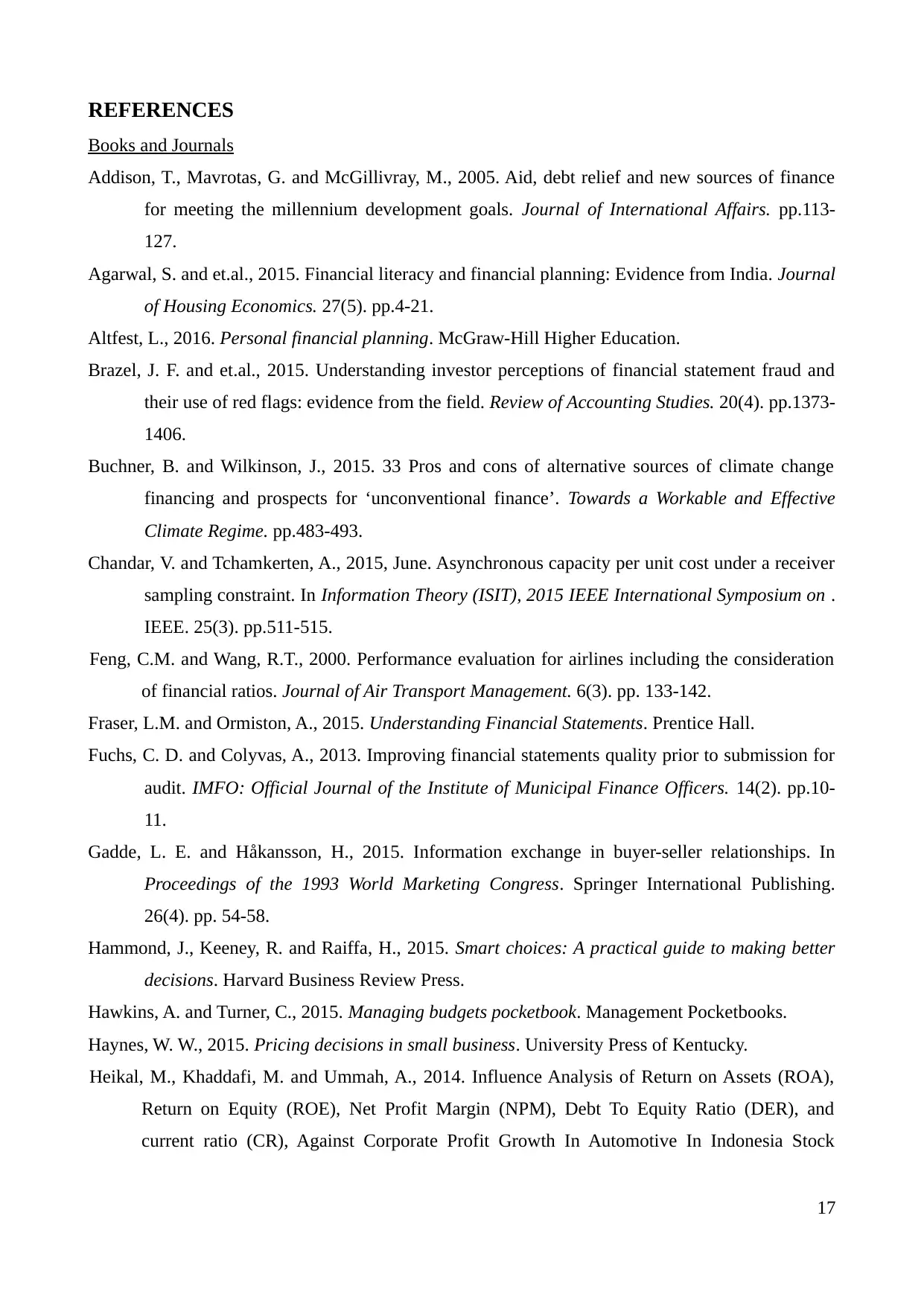
REFERENCES
Books and Journals
Addison, T., Mavrotas, G. and McGillivray, M., 2005. Aid, debt relief and new sources of finance
for meeting the millennium development goals. Journal of International Affairs. pp.113-
127.
Agarwal, S. and et.al., 2015. Financial literacy and financial planning: Evidence from India. Journal
of Housing Economics. 27(5). pp.4-21.
Altfest, L., 2016. Personal financial planning. McGraw-Hill Higher Education.
Brazel, J. F. and et.al., 2015. Understanding investor perceptions of financial statement fraud and
their use of red flags: evidence from the field. Review of Accounting Studies. 20(4). pp.1373-
1406.
Buchner, B. and Wilkinson, J., 2015. 33 Pros and cons of alternative sources of climate change
financing and prospects for ‘unconventional finance’. Towards a Workable and Effective
Climate Regime. pp.483-493.
Chandar, V. and Tchamkerten, A., 2015, June. Asynchronous capacity per unit cost under a receiver
sampling constraint. In Information Theory (ISIT), 2015 IEEE International Symposium on .
IEEE. 25(3). pp.511-515.
Feng, C.M. and Wang, R.T., 2000. Performance evaluation for airlines including the consideration
of financial ratios. Journal of Air Transport Management. 6(3). pp. 133-142.
Fraser, L.M. and Ormiston, A., 2015. Understanding Financial Statements. Prentice Hall.
Fuchs, C. D. and Colyvas, A., 2013. Improving financial statements quality prior to submission for
audit. IMFO: Official Journal of the Institute of Municipal Finance Officers. 14(2). pp.10-
11.
Gadde, L. E. and Håkansson, H., 2015. Information exchange in buyer-seller relationships. In
Proceedings of the 1993 World Marketing Congress. Springer International Publishing.
26(4). pp. 54-58.
Hammond, J., Keeney, R. and Raiffa, H., 2015. Smart choices: A practical guide to making better
decisions. Harvard Business Review Press.
Hawkins, A. and Turner, C., 2015. Managing budgets pocketbook. Management Pocketbooks.
Haynes, W. W., 2015. Pricing decisions in small business. University Press of Kentucky.
Heikal, M., Khaddafi, M. and Ummah, A., 2014. Influence Analysis of Return on Assets (ROA),
Return on Equity (ROE), Net Profit Margin (NPM), Debt To Equity Ratio (DER), and
current ratio (CR), Against Corporate Profit Growth In Automotive In Indonesia Stock
17
Books and Journals
Addison, T., Mavrotas, G. and McGillivray, M., 2005. Aid, debt relief and new sources of finance
for meeting the millennium development goals. Journal of International Affairs. pp.113-
127.
Agarwal, S. and et.al., 2015. Financial literacy and financial planning: Evidence from India. Journal
of Housing Economics. 27(5). pp.4-21.
Altfest, L., 2016. Personal financial planning. McGraw-Hill Higher Education.
Brazel, J. F. and et.al., 2015. Understanding investor perceptions of financial statement fraud and
their use of red flags: evidence from the field. Review of Accounting Studies. 20(4). pp.1373-
1406.
Buchner, B. and Wilkinson, J., 2015. 33 Pros and cons of alternative sources of climate change
financing and prospects for ‘unconventional finance’. Towards a Workable and Effective
Climate Regime. pp.483-493.
Chandar, V. and Tchamkerten, A., 2015, June. Asynchronous capacity per unit cost under a receiver
sampling constraint. In Information Theory (ISIT), 2015 IEEE International Symposium on .
IEEE. 25(3). pp.511-515.
Feng, C.M. and Wang, R.T., 2000. Performance evaluation for airlines including the consideration
of financial ratios. Journal of Air Transport Management. 6(3). pp. 133-142.
Fraser, L.M. and Ormiston, A., 2015. Understanding Financial Statements. Prentice Hall.
Fuchs, C. D. and Colyvas, A., 2013. Improving financial statements quality prior to submission for
audit. IMFO: Official Journal of the Institute of Municipal Finance Officers. 14(2). pp.10-
11.
Gadde, L. E. and Håkansson, H., 2015. Information exchange in buyer-seller relationships. In
Proceedings of the 1993 World Marketing Congress. Springer International Publishing.
26(4). pp. 54-58.
Hammond, J., Keeney, R. and Raiffa, H., 2015. Smart choices: A practical guide to making better
decisions. Harvard Business Review Press.
Hawkins, A. and Turner, C., 2015. Managing budgets pocketbook. Management Pocketbooks.
Haynes, W. W., 2015. Pricing decisions in small business. University Press of Kentucky.
Heikal, M., Khaddafi, M. and Ummah, A., 2014. Influence Analysis of Return on Assets (ROA),
Return on Equity (ROE), Net Profit Margin (NPM), Debt To Equity Ratio (DER), and
current ratio (CR), Against Corporate Profit Growth In Automotive In Indonesia Stock
17
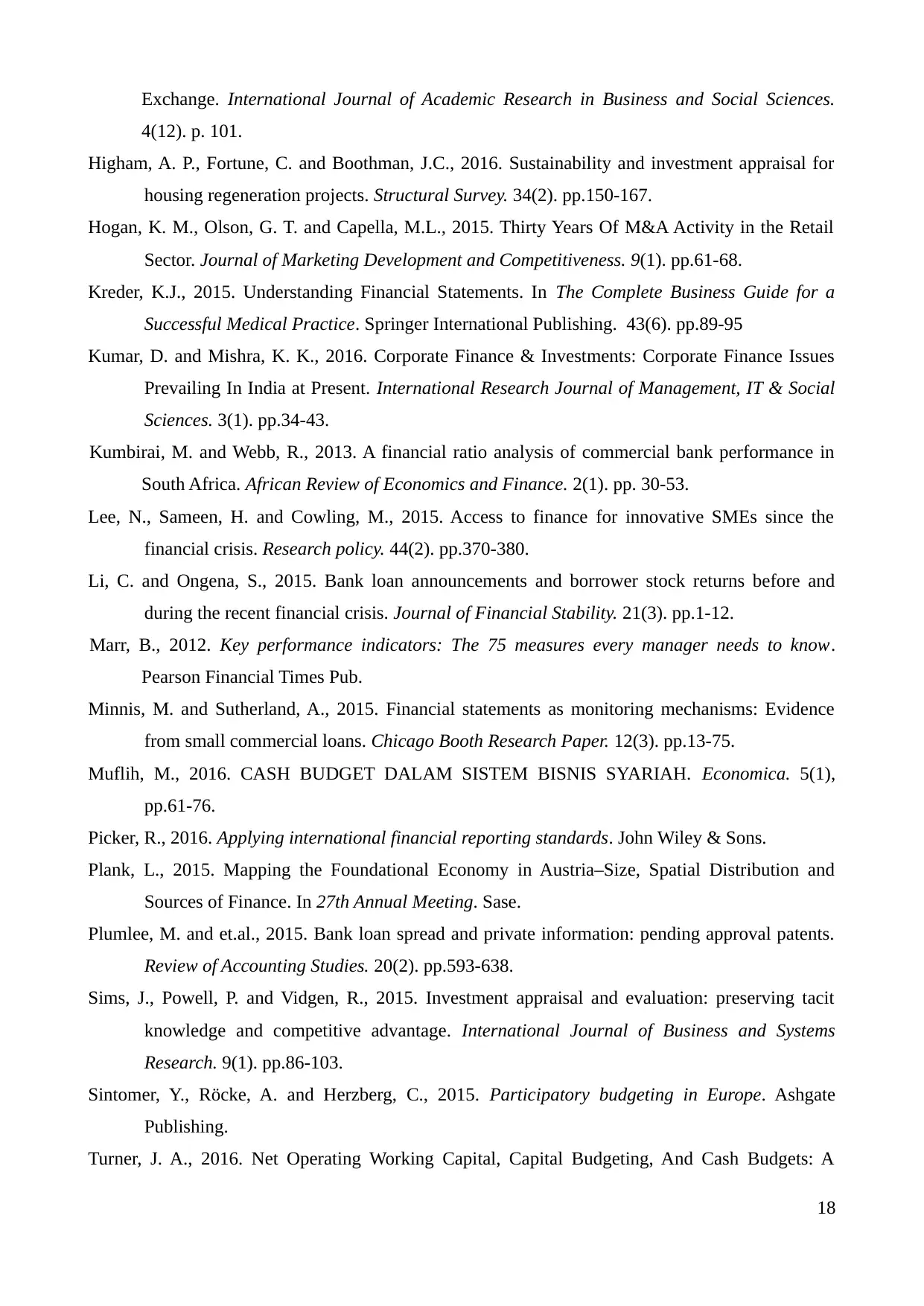
Exchange. International Journal of Academic Research in Business and Social Sciences.
4(12). p. 101.
Higham, A. P., Fortune, C. and Boothman, J.C., 2016. Sustainability and investment appraisal for
housing regeneration projects. Structural Survey. 34(2). pp.150-167.
Hogan, K. M., Olson, G. T. and Capella, M.L., 2015. Thirty Years Of M&A Activity in the Retail
Sector. Journal of Marketing Development and Competitiveness. 9(1). pp.61-68.
Kreder, K.J., 2015. Understanding Financial Statements. In The Complete Business Guide for a
Successful Medical Practice. Springer International Publishing. 43(6). pp.89-95
Kumar, D. and Mishra, K. K., 2016. Corporate Finance & Investments: Corporate Finance Issues
Prevailing In India at Present. International Research Journal of Management, IT & Social
Sciences. 3(1). pp.34-43.
Kumbirai, M. and Webb, R., 2013. A financial ratio analysis of commercial bank performance in
South Africa. African Review of Economics and Finance. 2(1). pp. 30-53.
Lee, N., Sameen, H. and Cowling, M., 2015. Access to finance for innovative SMEs since the
financial crisis. Research policy. 44(2). pp.370-380.
Li, C. and Ongena, S., 2015. Bank loan announcements and borrower stock returns before and
during the recent financial crisis. Journal of Financial Stability. 21(3). pp.1-12.
Marr, B., 2012. Key performance indicators: The 75 measures every manager needs to know.
Pearson Financial Times Pub.
Minnis, M. and Sutherland, A., 2015. Financial statements as monitoring mechanisms: Evidence
from small commercial loans. Chicago Booth Research Paper. 12(3). pp.13-75.
Muflih, M., 2016. CASH BUDGET DALAM SISTEM BISNIS SYARIAH. Economica. 5(1),
pp.61-76.
Picker, R., 2016. Applying international financial reporting standards. John Wiley & Sons.
Plank, L., 2015. Mapping the Foundational Economy in Austria–Size, Spatial Distribution and
Sources of Finance. In 27th Annual Meeting. Sase.
Plumlee, M. and et.al., 2015. Bank loan spread and private information: pending approval patents.
Review of Accounting Studies. 20(2). pp.593-638.
Sims, J., Powell, P. and Vidgen, R., 2015. Investment appraisal and evaluation: preserving tacit
knowledge and competitive advantage. International Journal of Business and Systems
Research. 9(1). pp.86-103.
Sintomer, Y., Röcke, A. and Herzberg, C., 2015. Participatory budgeting in Europe. Ashgate
Publishing.
Turner, J. A., 2016. Net Operating Working Capital, Capital Budgeting, And Cash Budgets: A
18
4(12). p. 101.
Higham, A. P., Fortune, C. and Boothman, J.C., 2016. Sustainability and investment appraisal for
housing regeneration projects. Structural Survey. 34(2). pp.150-167.
Hogan, K. M., Olson, G. T. and Capella, M.L., 2015. Thirty Years Of M&A Activity in the Retail
Sector. Journal of Marketing Development and Competitiveness. 9(1). pp.61-68.
Kreder, K.J., 2015. Understanding Financial Statements. In The Complete Business Guide for a
Successful Medical Practice. Springer International Publishing. 43(6). pp.89-95
Kumar, D. and Mishra, K. K., 2016. Corporate Finance & Investments: Corporate Finance Issues
Prevailing In India at Present. International Research Journal of Management, IT & Social
Sciences. 3(1). pp.34-43.
Kumbirai, M. and Webb, R., 2013. A financial ratio analysis of commercial bank performance in
South Africa. African Review of Economics and Finance. 2(1). pp. 30-53.
Lee, N., Sameen, H. and Cowling, M., 2015. Access to finance for innovative SMEs since the
financial crisis. Research policy. 44(2). pp.370-380.
Li, C. and Ongena, S., 2015. Bank loan announcements and borrower stock returns before and
during the recent financial crisis. Journal of Financial Stability. 21(3). pp.1-12.
Marr, B., 2012. Key performance indicators: The 75 measures every manager needs to know.
Pearson Financial Times Pub.
Minnis, M. and Sutherland, A., 2015. Financial statements as monitoring mechanisms: Evidence
from small commercial loans. Chicago Booth Research Paper. 12(3). pp.13-75.
Muflih, M., 2016. CASH BUDGET DALAM SISTEM BISNIS SYARIAH. Economica. 5(1),
pp.61-76.
Picker, R., 2016. Applying international financial reporting standards. John Wiley & Sons.
Plank, L., 2015. Mapping the Foundational Economy in Austria–Size, Spatial Distribution and
Sources of Finance. In 27th Annual Meeting. Sase.
Plumlee, M. and et.al., 2015. Bank loan spread and private information: pending approval patents.
Review of Accounting Studies. 20(2). pp.593-638.
Sims, J., Powell, P. and Vidgen, R., 2015. Investment appraisal and evaluation: preserving tacit
knowledge and competitive advantage. International Journal of Business and Systems
Research. 9(1). pp.86-103.
Sintomer, Y., Röcke, A. and Herzberg, C., 2015. Participatory budgeting in Europe. Ashgate
Publishing.
Turner, J. A., 2016. Net Operating Working Capital, Capital Budgeting, And Cash Budgets: A
18
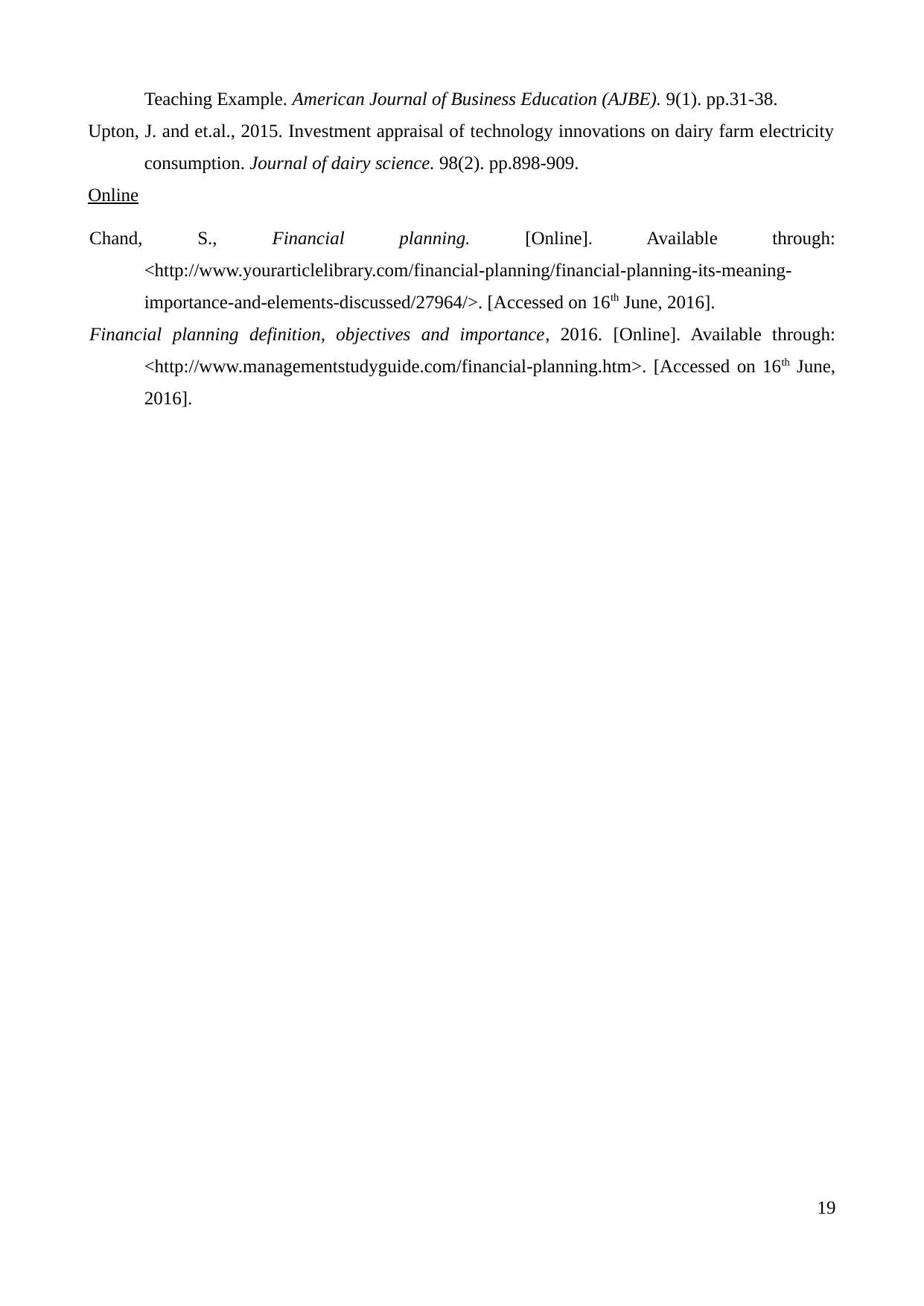
Teaching Example. American Journal of Business Education (AJBE). 9(1). pp.31-38.
Upton, J. and et.al., 2015. Investment appraisal of technology innovations on dairy farm electricity
consumption. Journal of dairy science. 98(2). pp.898-909.
Online
Chand, S., Financial planning. [Online]. Available through:
<http://www.yourarticlelibrary.com/financial-planning/financial-planning-its-meaning-
importance-and-elements-discussed/27964/>. [Accessed on 16th June, 2016].
Financial planning definition, objectives and importance, 2016. [Online]. Available through:
<http://www.managementstudyguide.com/financial-planning.htm>. [Accessed on 16th June,
2016].
19
Upton, J. and et.al., 2015. Investment appraisal of technology innovations on dairy farm electricity
consumption. Journal of dairy science. 98(2). pp.898-909.
Online
Chand, S., Financial planning. [Online]. Available through:
<http://www.yourarticlelibrary.com/financial-planning/financial-planning-its-meaning-
importance-and-elements-discussed/27964/>. [Accessed on 16th June, 2016].
Financial planning definition, objectives and importance, 2016. [Online]. Available through:
<http://www.managementstudyguide.com/financial-planning.htm>. [Accessed on 16th June,
2016].
19
1 out of 19
Related Documents
Your All-in-One AI-Powered Toolkit for Academic Success.
+13062052269
info@desklib.com
Available 24*7 on WhatsApp / Email
![[object Object]](/_next/static/media/star-bottom.7253800d.svg)
Unlock your academic potential
© 2024 | Zucol Services PVT LTD | All rights reserved.





